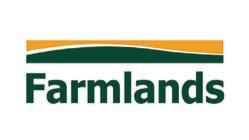




ELOISE MARTYN
Nelson Tasman winegrowers welcome the Sale and Supply of Alcohol (Winery Cellar Door Tasting) Amendment Bill’s approval after its third reading. The changes now allow winery cellar doors with an off-license to charge for wine tastings, addressing previous financial hurdles in covering operational expenses.
“I view this as a very positive step which addresses long-standing issues for those in the winery industry,” Paul Miles co-owner of Riwaka River Estate vineyard and winery and Chairperson of Nelson Winegrowers Association Incorporated says.
Paul has been a key advocate for this change, representing both Riwaka River Estate and Nelson
Winegrowers Association Incorporated as the Amendment Bill made its way through the legislative process.
“This update means our winery cellar doors have the option to charge for tastings as they see fit, along with a requirement to offer snack food for sale. Our cellar doors play a key role in our regional tourism story and its activities, and they are, in effect, ambassadors for our region. This change brings them more in line with other tourism operators and will enable them to continue to provide visitors with an incredible tourism experience,” Paul explains.
Rosie Finn from Neudorf
yards says it’s fantastic news and














News
Eloise Martyn eloise@topsouthmedia.co.nz
Advertising Sales
Danielle Brown danielle@topsouthmedia.co.nz
Summa Donald summa@topsouthmedia.co.nz
Steve Page steve@nmf.co.nz
Accounts Queries accounts@topsouthmedia.co.nz
563 Main Road
Repair work in the Marlborough Sounds will “accelerate” after the NZTA board approved $100m in funding, although not everything the council asked for has been signed off.
Mark Owen, New Zealand Transport Agency Waka Kotahi regional manager for the top south, said the board approved funding for the next phase of storm works in the outer sounds.
The Marlborough District Council had made an application to the board for $141.4m, which the board agreed to fund 71% of, or $100.4m.
Marlborough mayor Nadine Taylor welcomed the news.
“This is the confirmation we needed to accelerate work on the road repairs required,” Taylor said.
Taylor said the priority was to get Kenepuru Rd open to a state where there was full public access, and trucks could be allowed through.

Damage on Queen Charlotte Dr after the July 2021 flood event. Supplied: Ricky Wilson/Stuff.
“We know the Kenepuru community has been waiting for a long time for this certainty. Because of the cost of the repairs, we needed the NZTA funding confirmed to proceed with confidence to get the work done and let residents and businesses in the area to get back to normal.”
The estimated repair bill for the roads badly damaged in storm events in July 2021 and August 2022, was $230m.
Some of this included road improvement costs, which the NZTA board said was subject to further detailed design work.
Taylor said the council would



continue to work with NZTA to confirm the appropriate business case approach for the road improvements and the expected timeline for that work.
Taylor said the council “of course” had hoped the entire business case for the roads was approved.
“But if we have a little bit further to travel to secure the remaining funds required for road improvements, then that is what we will do on behalf of our affected communities. This is not only about roads – it is about real people who are at the heart of Marlborough’s largest recovery project.I hope today’s decision brings some comfort to those affected that we can now proceed with confidence to repair these roads.”
It comes after the Marlborough District Council finalised how it would pay its $104m share of the repair bill for the flood-damaged roads at a meeting in June, following consultation with the community through its long-term plan.
After considering hundreds of sub-
missions, the final cost to ratepayers was tweaked from the council’s draft plan released for consultation in April.
It drastically reduced how much Kenepuru ratepayers would pay by slightly increasing the charges to non-Sounds zones. Kenepuru had the largest repair bill out of the five Marlborough Sounds zones. However, most ratepayers had an overall decrease in the amount they would pay towards the repairs, because the council abandoned its $40m marine infrastructure upgrade plans. A $500,000 marine study was still in the budget. On top of their rates, which have in Marlborough increased by 13.6%, an average Kenepuru property owner would pay $34 in 2025, and $131 in 2026, but they would ramp up over the years, reaching $705 by 2034 – far less than the original proposal of $1224. Queen Charlotte ratepayers would pay $16 in 2025. By 2034, this would be $344 - about $11 more on average than first proposed, because the zone had already had priority repairs.
An average non-Sounds ratepayer would pay $9 in 2025 and $35 in 2026 towards the roads, ramping up to $187 on average by 2034 –a decrease of $60 from the first proposal.

FROM PAGE 1
will make a huge significant difference to small wineries and the NZ wine brand. And this change will improve the customer experience as wineries will be more inclined to pour their more expensive bottles. “I think normalising charging for tastings brings us in line with other world-famous wine regions,” Rosie adds.
The new regulations will take effect before the bustling summer season, ensuring winery cellar
doors uphold responsible hosting practices. These include limiting sample sizes to a maximum of 35ml and complying with new requirements to offer snack food for sale and provide free water. These adjustments aim to assist cellar doors in meeting their expenses and encourage the establishment of new winery cellar doors that may not have been economically viable previously. This initiative is also expected to generate employment opportunities and enhance tourism experiences.


Feds urge rates be reined in
Federated Farmers say that they have heard from some farmers ‘paying upwards of $1000 a week in rates and not getting a hell of a lot for it.’ Rate bills are a huge expense for farmers with many paying tens of thousands of dollars every year. That makes the current round of rate hikes even more concerning Federated Farmers, with an average increase of 14% across the country — so they have been pushing back strongly. On behalf of their members, they have lodged over 60 submissions with local councils to contest their rating decisions. They have also run countless media stories calling on councils to tighten their belts and cut unnecessary spending. However, they say ‘unfortunately, in most cases our concerns have fallen on deaf ears, with the councils arguing all of their costs are rising with high inflation and changes to Government policy’. But all of that changed in September with the Prime Minister announcing the Government will be making a series of policy changes to rein in rates increases, cut wasteful spending, and get councils re-focused on their core business. Federated Farmers will be engaging in this process on behalf of their members and working to ensure there are never double-digit rates rises, like the ones we’re seen this year.
New Zealand-based Ruminant Biotech has created a compact metal capsule, or bolus, designed to release a powerful methane-reducing medication into an animal’s digestive system. The compound inside the capsule is derived from a specific type of seaweed. However, the goal is to produce it in a New Zealand-based industrial facility rather than collecting large quantities of seaweed. While there is already a methane-reducing product available for feedlot cattle abroad, addressing the issue for grazing animals, such as those in New Zealand, has proven more challenging. A solution to the methane-rich burps of dairy
cows might be available for New Zealand farmers next year, but Australian farmers will receive it first. Tests revealed that a single dose of the new product cut a cow’s planet-warming methane emissions by 75% for 100 days. Researchers are now working to extend the effect to last for six months with the aim of having it available for use in Australia in 2025 and in New Zealand by 2027.

Trade Commissioner to Malaysia and Thailand Suzy Fewtrell, Fatric CEO Chin Keong Yap, Prime Minister Rt Hon Christopher Luxon and Alliance CEO Willie Wiese. Photo: Supplied.
Alliance has signed two agreements in South Korea and Malaysia in the presence of New Zealand Prime Minister Rt Hon Christopher Luxon. The Memorandums of Understanding (MoU) with South Korean distributor Daesang Corporation and Fatric in Malaysia lay the foundation for Alliance to expand our premium red meat portfolio in both countries.
Daesang, one of the leading producers of traditional Korean foods and a food innovation leader, will spearhead the promotion of Alliance’s award-winning Lumina Lamb and educate its customers and consumers about New Zealand lamb and beef. Meanwhile, Alliance’s MoU with partner Fatric will pave the way for the expansion of their premium lamb and mutton programme in Malaysia.
Alliance Pukeuri is one of just five New Zealand lamb plants licensed to supply Malaysia. The two agreements were signed as part of Prime Minister Luxon’s official trade delegation to South Korea and Malaysia.
ANDREW RITCHIE
“Green shoots are appearing in the global sheep meat market,”according to Rabobank’s Senior Animal Protein Analyst, Jen Cokran.
Speaking to a Farming for Profit group in Marlborough she said the global red meat sector has endured some volatile times in recent years.
“The Ukraine war has been influential in driving up farm costs, and turmoil in the Middle East has resulted in additional shipping costs caused by the lack of security in the Suez Canal.”
Jen says the extra 14 days travel has imposed a risk to the chilled product market. The challenges faced by China’s economic malaise continues. They account for 60 per cent of our sheep meat exports, 40 per cent of our beef and 30 per cent of dairy.
“This should serve as a warning that we must look to diver-
sify our export destinations. New Zealand and Australia are responsible for most of the sheep meat produced globally but there is an imbalance in our dependence on the Chinese market,” she said. New Zealand exports 145 thousand tonnes while Australia exports 78 thousand tonnes.
“Interestingly, NZ’s home consumption of sheep meat is 1.9kgs per capita whereas the Australians consume 6kgs per head.”

The green shoots emerging are coming from a reduced supply from Australia, and our higher value export markets continue to take increased volumes. The UK, EU and the US are the three biggest markets after China. The EU is the most valuable market, bringing in $63.3
million dollars up 25 per cent on 2023.Export volume to the UK up 92 per cent year on year representing a 95 er cent upswing in value, reaching $40.2 million dollars.
As reported by Beef and Lamb NZ sheep numbers have dropped by 4.3 per cent to 23.3 million. They attribute this to land use change, pockets of drought over the last 18 months and slightly lower lambing percentages compared to 2023.
The South Island lamb price continues its upward trend and is now back within the five-year average at $7.70 per kilogram to the beginning of September.
The total value of sheep meat exports for July were up 5.4 per cent YOY to $255.7 million.
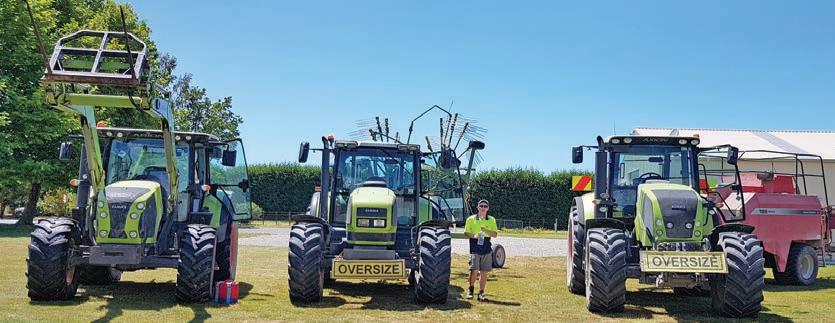


LIC is embarking on a project to breed heat-tolerant and diseaseresistant dairy cows for SubSaharan Africa, in collaboration with the global leader in precision breeding, Acceligen, and the Bill & Melinda Gates Foundation.
The initiative seeks to address food insecurity in the region by providing high-performing dairy animals to help grow sustainable dairy markets, contributing to improving human and animal welfare. It will combine LIC’s expertise in breeding efficient dairy cows for pasture-based systems, with Acceligen’s cutting-edge gene editing capabilities to produce animals that can produce more milk than native species. Speaking about the initiative, LIC


Embryos bred from LIC’s worldclass pasture-based genetics are about to be sent around the world. Photo: Supplied.
Chief Executive David Chin emphasises the benefit of this global collaboration. “This is a big one for LIC and we are proud to be involved. Collaborating with Acceligen allows us to work with the very best in the world, whilst showcasing our advanced breeding capability to global markets. The initiative supports us to stay at the forefront of the latest technologies and is an opportunity to leverage international expertise with positive benefits for the dairy sector. As a leader in pasture-based dairy genetics and a farmer-owned co-operative, LIC supports dairy farmers to navigate their unique challenges and, in particular, provide them with the right tools to breed the most sustainable and profitable herds, now and into the future. Gene editing technologies could help give farmers even more tools to improve their productivity and efficiency – and that’s something we have to explore,” says Chin. Embryos bred from LIC’s worldclass pasture-based genetics will be sent to the United States, where
Acceligen will perform gene edits on the stem cells. The embryos will then be transferred into dams that will give birth to gene-edited sires. The bull calves will be transported to Brazil for rearing. The semen will be collected from these sires and sold into Sub-Saharan African markets through a developed distributor network. Locally, the New Zealand Government has committed to legislative change to enable the greater use of gene technologies, ending the effective ban on gene editing by the end of 2025. Chin says LIC is actively looking at the science and viability of adopting such tools for New Zealand farmers. “As an organisation, we continue to explore gene editing as a breeding technology to ensure the co-operative stays current with this area of science so we can understand
how the sector may adopt it in the future. LIC is supportive of tools that can enhance the productivity of the dairy sector, and we are ready to adopt new technologies to meet the demands of a changing world.”
The project is funded by the Bill & Melinda Gates Foundation with a budget of $5 million USD ($8.3 million NZD). The organisation invests heavily in agriculture development to support farmers in Sub-Saharan Africa in their efforts to sustainably raise healthy, productive animals.
“LIC is a globally connected business, and this is a truly global collaboration,” says Chin. “We’re excited to learn from the best, help advance science and innovation in herd improvement, and improve outcomes for farming communities.”
ANDREW HOGGARD
Minister for Biosecurity
The Ministry for Primary Industries presented three management options for consideration - ‘stamping out’ the disease, with the possible use of emergency vaccination for short-term containment as needed; managing an outbreak over a longer period using vaccination; or living with the disease. Biosecurity Minister Andrew Hoggard says that a new economic impact analysis report reinforc-
es this government’s commitment to ‘stamp out’ any New Zealand foot and mouth disease incursion.
“The new analysis, produced by the New Zealand Institute of Economic Research, shows an incursion of the disease in New Zealand would have dramatic impacts, with an immediate halt to most exports of animal products and a potential and ongoing drop in export values of around $14.3 billion a year,” says Mr Hoggard.
“Immediate and decisive action will be required if an outbreak oc-

curred and this is why Cabinet has endorsed an approach of urgent eradication, along with the use of vaccination if appropriate.”
“The Ministry for Primary Industries presented three management options for consideration - ‘stamping out’ the disease, with the possible use of emergency vaccination for short-term containment as needed; managing an outbreak over a longer period using vaccination; or living with the disease. The evidence clearly supported ‘stamping out’ the disease,
either with or without emergency vaccination.”
“Using emergency vaccination would take around 10 months to achieve, cost around $1.9 billion in operating costs and compensation, and see a one-off $8.4 billion impact on the economy in lost trade. The option to stamp out without vaccination would take 15 months, cost $2.98 billion and carry a $15.3 billion dollar loss of trade.
“Living with the disease would have an ongoing annual economic
impact of $14.3 billion.”
“I’m releasing the economic analysis report and the Cabinet Paper on the initial strategic response so people can understand the impacts of foot and mouth disease and the importance of keeping it out of the country and preparing to effectively manage it if it occurred.The best way to manage any incursion is to keep unwanted pests and diseases out in the first place which is why the Government is committed to maintaining a strong border, and robust biosecurity systems.”









For 43 years, Bearing and Engineering Supplies Ltd has been a cornerstone of Nelson’s industrial landscape, offering top-quality bearings, engineering supplies, and exceptional customer service. Established on May 4, 1981, as the ‘Bearing and Transmission Centre’ in McGlashen Ave, it quickly became a trusted name in the industry. Over the decades, the business evolved to meet growing customer demands, recently relocating to a larger site at Estuary Place in Richmond.
Manager Rick Ivory highlights the company’s founding principles of honesty, loyalty, and service, which still guide them today. In the late 1980s, they expanded with a Richmond branch, and by 1999, after identifying a gap in the market, began offering specialized engineering supplies. This led to the 2000 launch of ‘Nelson Engineering Supplies’ and
the eventual amalgamation of both businesses, providing a comprehensive range of products under one roof.
In 2005, they began importing key products from Australia, Singapore, and England, enhancing their competitive edge. The foundation of the company’s success has always been built on its commitment to providing high-quality products, excellent customer service, and a team of knowledgeable staff. Today, the company boasts a combined industry experience of over 200 years, ensuring that their customers receive expert advice and solutions.
What sets Bearing and Engineering Supplies Ltd apart from other suppliers in the region is its vast product range, deep industry expertise, and commitment to customer service. With a team of 10 dedicated staff, the company’s motto is to ‘provide solutions
to meet your needs’—a promise that has been at the heart of their business for over four decades. Their willingness to go the extra mile, combined with their ability to source quality products from respected international suppliers, has earned them a loyal customer base across New Zealand. “Whether a customer needs bearings, power transmission components, or specialised engineering products, they know they can rely on Bearing and Engineering Supplies Ltd to deliver.”
Their new Richmond location, built by InHaus, has been a game-changer for Bearing and Engineering Supplies Ltd and provides more space for better product displays and customer access. With a dedicated team of 10 staff, Bearing and Engineering Supplies continues to grow, offering solutions that meet the needs of their customers across New Zealand.

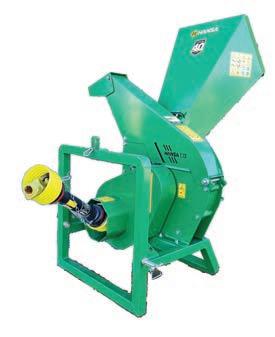






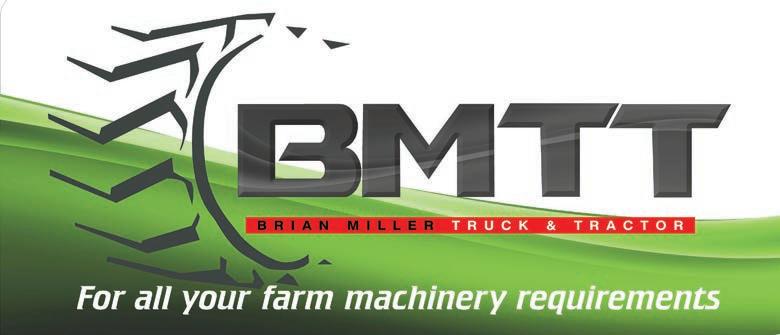






Horticulture New Zealand (HortNZ) is urging the Government to incorporate the horticulture sector into its second Emissions Reduction Plan.
The current plan, outlining actions to reduce emissions between 2026 and 2030, makes no mention of horticulture, fruits, or vegetables. “It is concerning that the Emissions Reduction Plan (ERP2) overlooks horticulture entirely,” says Michelle Sands, acting chief executive of HortNZ. “The sector is crucial for meeting emissions reduction targets and supporting land-use change to horticulture is one of the many solutions New Zealand should be leveraging.
“Horticulture is already a low-emissions land use that provides food for New Zealanders and the global market, contributing $7.48 billion in value across domestic and export markets. This is achieved on less than 0.1% of New Zealand’s land area while accounting for only 1.1% of the country’s greenhouse gas emissions. To ensure a low-risk pathway to net-zero, the Government should develop a diverse portfolio of emissions reduction policies, rather than relying heavily on a few uncertain technological advances.”
The Climate Change Commission has included 14,000 hectares of land use to horticulture in its demonstration path to meet the second emissions budget. HortNZ wants ERP2 to include clear policy
direction supporting this transition. This should involve recognising diversification into horticulture as a key policy and elevating ‘enabling the supply of fresh fruits and vegetables’ to a matter of national importance under the Resource Management Act (RMA) and its replacement legislation. Additionally, ERP2 include the policy aim to establish a national framework for commercial vegetable production to address the challenges posed by unworkable regional regulations.
With the Government Investment in Decarbonising Industry (GIDI) Fund officially disestablished under ERP2, HortNZ is also calling for the creation of a new fund to reinvest Emissions Trading Scheme (ETS) proceeds into greenhouse decarbonisation.
“There is an urgent need for policy mechanisms that facilitate horticultural expansion as a strategy for low-emissions food production, and that provide resources for the sector to further decarbonise,” said Sands. “HortNZ urges the Government to commit to doubling the horticulture sector’s value by 2035 as part of its emissions reduction strategy, aligning with the goals of the Aotearoa Horticulture Action Plan, a strategy co-owned by government, industry, science, and Māori.”
Horticulture New Zealand represents the interests of approximately 4,500+ commercial fruit and vegetable growers across the country, who produce around 100 different fruit and vegetables. The horticultural sector supports over 40,000 jobs.
We’re excited to share the news that Scott Burnett has stepped into the role as chair of Tasman Environmental Trust (TET). Scott brings with him a rich background of experience and passion for environmental conservation.
Scott’s connection to the natural world was nurtured in the hills of Wellington. His diverse career includes roles as a builder, outdoor instructor, and work with Greenpeace, where he met his wife, Rachel. Together, they founded Pacific Discovery and over 18 years delivered cultural and adventure experiences to 2,500 students across sixteen countries.
goats, 15 pigs, and 19 deer from the 640-hectare property to date.
As we welcome Scott, we’re also saying a huge thank you to Gillian Bishop, who steps down as chair but remains on the TET board. Gillian’s been a driving force at TET since 2016 and a conservation pioneer at the Waimea Inlet over the last 20 years. Her remarkable contributions were recognised in 2020 with the Queen’s Service Medal.

Scott has a master’s degree exploring how community conservation contributes to Aotearoa’s National Biodiversity Strategy, Te Mana o Te Taiao. He has taught in Massey University’s Development Studies Programme and is now Top of the South Conservation Manager for Forest & Bird.
He has been a member of the TET board for the past two years. Stepping into the role of chair, Scott’s particularly interested in building strong relationships with iwi and coordinating conservation efforts to make sure conservation dollars have the most impact.
Scott and Rachel co-own an ecological restoration property in the Marlborough Sounds, a former sheep farm now naturally regenerating. Enrolled in the ETS as a native forest carbon farm, they use the proceeds to control predators and browsing pests, having successfully culled 894
Gillian’s journey with TET began when she was leading the Waimea Inlet Forum and they started ‘Battle for the Banded Rail, a community-led project to protect and restore the Inlet’s habitat. She joined TET as a trustee, and then chair. Under her leadership TET has expanded its support systems to other conservation groups – by taking care of the admin workload, allowing groups to focus their resources on the grassroots conservation mahi.
Reflecting on her years with TET, Gillian highlights the importance of community engagement and volunteer involvement in the projects TET supports. She’s proud of the growth and collaborative spirit that has been fostered.
Gillian believes in the power of community-led conservation, and strongly believes everyone has a role to play. Battle for the Banded Rail is a wonderful example of this with over 70 volunteers helping at some of the recent planting days. Her passion for protecting wild places and fostering community-driven conservation efforts has left an indelible mark on TET and the broader environmental community.


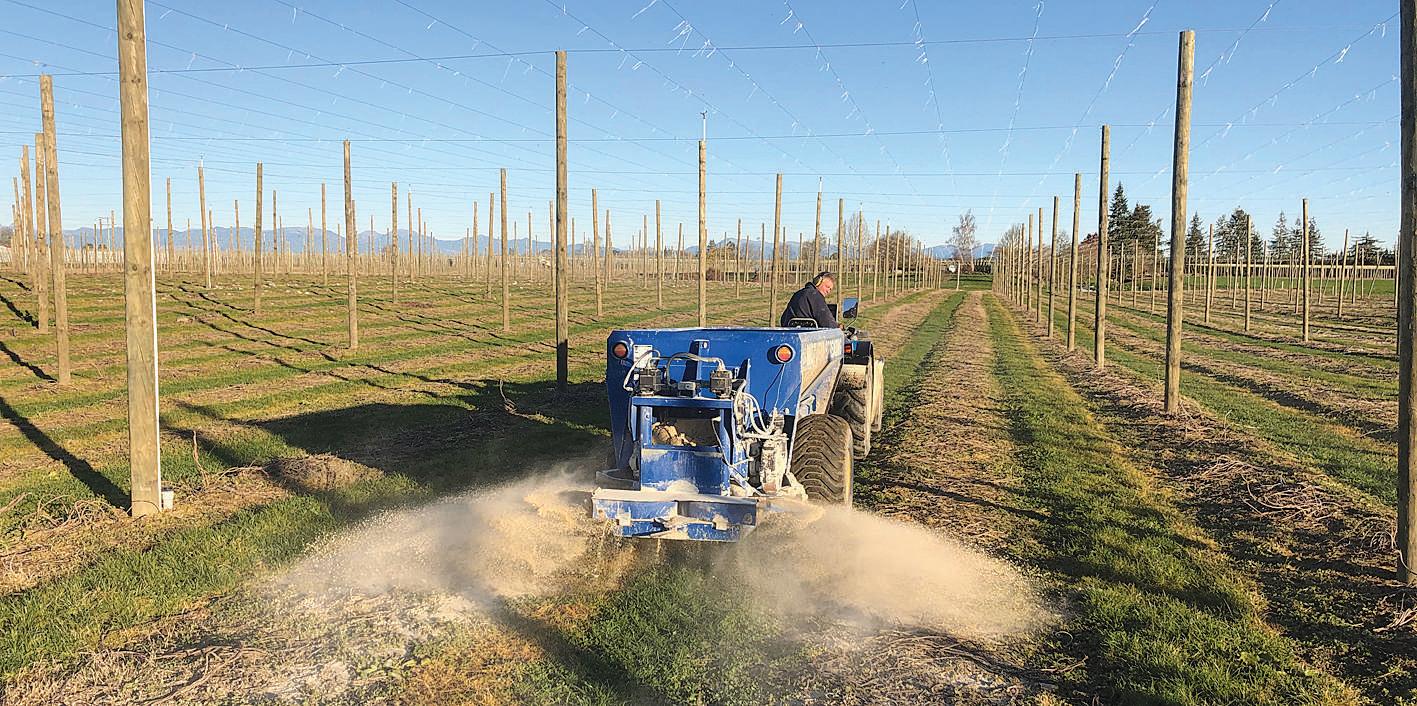


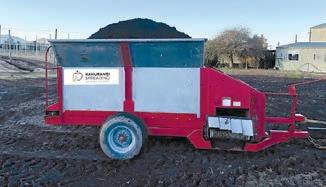





ANNE HARDIE
Twelve local growers who stepped out of their comfort zone and dared to bare for a calendar, have raised $25,000 for mental health. The Horti Boys 2024 calendar is a collection of bare-chested growers with sometimes as little as a bunch of flowers or wincingly, a frame of bees to hide behind, all in the name of fundraising for a good cause.
Ben Conning from Connings Food Market is the August model, posing bare chested in the celery crop of the family’s market garden and though he was “dropped in it”, it was all for a good cause.
The main recipient of the fundraiser is The Care Foundation, with a portion also going to Farmstrong, to be spent on mental health.
The foundation’s general manager, Clare Haywood, says it is fantastic for a bunch of rural guys to step out of their comfort zone to model for the calendar and the money will be spent locally in rural areas.
“I think I have to give them 10 out of 10 for their bravery. There would have been some cajoling because it’s really putting themselves out there.”

Two of the models, Hamish Rush and Evan Heywood, were the instigators of the calendar after seeing a close friend struggling with mental health issues. “We were out to dinner and
Over 80 farmers and rural professionals from across Tasman and Marlborough gathered at Lenticular Lake Station in St Arnaud for the first combined Beef + Lamb NZ Farming for Profit Field Day. The event marked a significant collaboration between the two regions, offering expert insights and practical farm management solutions.
thought, ‘what do we do?’” Hamish remembers. “Then the wives looked across and said: ‘you guys should do a fireman’s calendar’.”
While they are “really stoked” with the money raised, he says it also prompted discussion on mental health which was their primary drive.
Will they pose for another calendar? Maybe in a year or two, says Hamish who is featuring now in September. Or maybe it’s time for those who came up with the idea to do the modelling.
“We’re trying to convince all the wives to do it now.”
Attendees heard from Chris Sanders (PGG Wrightson Seeds) and Fraser Harrison (Agricom), who shared invaluable advice on crop and forage options, with Lenticular Lake Station’s Farm Manager, Tom Curnow, demonstrating how he’s put the advice into action. Since taking over the 1050ha property in July 2022, Curnow has implemented strategic improvements, including running just under 9,000 stock units, introducing new grass rotations, and achiev-

ing impressive winter crop yields.
B+LNZ’s Extension Manager for Tasman and Marlborough, Amanda Henderson says, “It’s been a great day with a fantastic turnout!”
Key takeaways from the day focused on the importance of getting the basics right. Amanda says, “One of the biggest messages was that if you don’t get it right the first time, it can cost you in the long run. Future-proofing is crucial. It’s all about understanding
2696 Kawatiri-Murchison Highway, Longford, Tasman, Nelson
towards the back of the home for easy access from the land. There is also new carpet throughout the home. Move on in and start living or add your own touches to the home. Enjoy lunch and bbq’s from the covered in large private deck with the best views of the hills and native bush.
Sharyn Miller 021 377 930 sharyn.miller@bayleys.co.nz
Lydia Heyward 027 432 8532 lydia.heyward@bayleys.co.nz
The garden is well fenced and established, plenty of room for kids and dogs to roam. A very handy three bay shed is located to the back of the house and one good size paddock for the lifestyle pets. Surrounded by farmland that

gives the feeling of living on a rural property without the tie of too much land as well as good access and pull over area from the highway.
If you are looking for a character home on a manageable sized lifestyle property, come and take a look for yourself.
Dylan Monopoli 027 340 5905 dylan.monopoli@bayleys.co.nz
Contact Sharyn @ Bayleys Country for further property information and to view.





My vendors have subdivided off a portion of their larger land holding and are offering it to the market for the next owner to enjoy and farm - the 13.37ha (subject to issue of Title) land is flat and productive with the number one asset being an irrigation right for 12ha - this is taken from an irrigation pond on the property. Stock and house water is from a well and the option of being included into the sale are two units of Eighty Eight Valley Water Scheme … Water is GOLD! The land is located between
what you have now and planning for the future.” She noted that investing in proper soil and fertility management, and selecting the right crops for specific farm conditions, are key to success.
The event featured a field tour, with stops at two paddocks to discuss summer brassicas and crop rotations, offering farmers practical advice on how to optimise pasture and crop production.
Attendees also learned about the benefits of oats for silage and the
importance of timing to ensure high returns.
Amanda says, “Thanks to the two Farming for Profit groups –Tasman and Marlborough – for thinking outside-the-box and combining to put together such a brilliant day. Lenticular Lake Station provided the perfect backdrop for discussions on crop options, pasture management, and how to future-proof forages. Thanks to the team for hosting us!”

Deadline sale (unless sold prior) Closes 1pm, Thu 10 Oct 2024
Higgins Road and Bridge Valley Road and has the Pitfure Stream running through part of it. The paddocks have good shelter belts, most of the property is deer fenced.
The Cottage is in original condition that has seen many generations of families who have enjoyed living there and is perfect for character lovers who want to add their own touch. Two bedrooms and a sunroom (currently used as a bedroom), separate lounge, large open plan living, dining and







kitchen. The garden contains some old rhododendron trees that one must imagine are as old as the house. Flat lawns and an area to plant veges, hen house all make for the perfect country home. Situated between Wakefield and Brightwater, properties don’t come up in this location often.
Note: pricing will be plus GST (if any).
Contact Sharyn at Bayleys Country for further property information and to arrange a viewing.
JOE BLAKISTON PGG Wrightson
I predicted a Tasman Mako Ranfurly Shield win, so in recent weeks I think plenty of Tasman supporters have been getting their share of the glow of this wonderful Trophy that is the sort of thing that lifts the spirits of a community.
I am also noticing an upswing in attitude and confidence, albeit minor, in the rural community as they see a new season beginning, and improved commodity prices – procurement war driven by the big meat companies, but I will take over $2000 for a prime steer any day! We welcome the continued rise in Dairy Trade prices and talk of further interest rate falls and on top of a good start to the season in most places add to the list of positives.
Of course, viticulture is still a tough space but once we are through the frost period that might right itself slightly.
The government changes to

the Resource Management Act allowing farmers to do what they want without draconian restrictions is welcomed as are the other ‘90day plan’ projects which are seeing our economy slowly emerge from recession. Small steps, but the right steps, I think. Getting rid of working from home for government and city workers is a great move as well for many businesses as we want to put all the Covid hangovers behind us. It works for some but as I write this at home, I am looking outside at lots of deferred
jobs I could be doing at home on a workday!
So, all in all, as we set ourselves up for a new season, I can see from the level of new listing enquiry and properties coming to the market that there has been a seachange in the market that I believe will see rural land sales increase from a pretty low level we have seen over the last six months.
The right time to market a property is when you are ready and time and time again, I have seen clients so pleased with outcomes despite the market they are selling in as it allows them to get on with their lives and take the next step in life, which is what the job of a good real estate agent is - good honest advice throughout the process, working hard to achieve an outcome and keeping you well informed along the journey.
I hope all our farming clients are optimistic about the season ahead…have a great month!


Joyce Wyllie from Pakawau is set to lead Rural Women of Golden Bay for the next three years, having been elected as provincial president in July. She takes over from Carolyn McLellan, who served nine years and decided to step down to bring fresh ideas to the role.
“It has been my honour and my privilege to represent the Province of Golden Bay, as the Rural Women President,” Carolyn McLellan explains. “I believe Rural Women plays a central role in our community thanks to our dedicated members who work together for the benefit of our own community. Each branch is filled with remarkable women, and I look forward to remaining involved with Rural Women as president of the Bainham branch.”
“Carolyn has done an exceptional job during her presidency, putting in tremendous effort, and she certainly deserves a break, “Incoming provincial president Joyce Wylie says, “I felt it was my turn to put my hand up, so I did.”
The province includes three Rural Women branches Tākaka, Pakawau, and Bainham.
Joyce has been involved with Pakawau Rural Women since 1997. She follows
the footsteps of her Mum who has a keen Rural Women member north of Gisborne when it was the Federated Farmers Women’s Division. “Rural Women offers three main prongs that I enjoy, social connection and friendships, community support, and the political side I like that we have a voice and some influence in Wellington,” Joyce says.
Farming has been a lifelong pursuit for Joyce, who was raised on a sheep and beef farm in Gisborne and worked as a vet on farms for 17 years. Together with her husband Jock, they run a 1000-hectare sheep farm. “With commodity prices low and input costs high sheep farming certainly has its challenges,” adds Joyce.
Looking ahead, the Pakawau branch will celebrate its 90th anniversary next year, coinciding with the national branch’s centennial milestone.
“There is something special on the horizon to celebrate,” Joyce says. “We will be looking back and celebrating all the women before us and all the good that has been done, I think many of us are really looking forward to this.”
In the meantime, the group remains active, currently planning an ‘International Day’ focused on Filipino culture, featuring Filipino food speaker and cultural insights.
Astin Knowles is your new local fencer. Based and trained in Tasman, he is now starting his own contracting business specialising in rural and domestic fencing.
He prides himself with a couple of advantages, in that he’s a quick, hard worker and he will always be reasonable in his pricing.
Having just completed a stylish pool fence in Appleby, as well as 2km of deer fencing and 1km of sheep fencing on a Murchison farm, he’s proven he’s able to put his hand to a wide variety of applications. This includes deer and sheep fencing, timber and pool fencing, 8-9 wire and batten fencing, hot wires, gate installations and construction of stockyards. He also specialises in fence repairs and stock proofing. Astin says no job is too big or small. “I am always
happy to work with homeowners, lifestyle block owners and farmers to help them get exactly what they need and get it built within their timeline.”
Contact Astin on mobile, day, evenings and weekends are fine.
All his work carries his personal guarantee of satisfaction.

GARRICK BATTEN
The previous Minister stated that handling Climate Change risks must be met with both mitigation and adaptation. Later, he said climate change is fiendishly complex, impinging on private property rights, insurance markets, banks, the division of responsibility between central and local government, and on the treatment of claims and compensation. The universal approach to handling such risks favours managing natural hazards with response and recovery rather than reducing their risks and also increasing resilience by adaption. However, farm management of adverse climate risks such as drought and floods are constrained by Bank lending with higher farm capital levels. Insurers require policyholders to account for reducing risks by increasing premiums. When the computer spell-checker keeps
wanting to change, adapt to adopt, no wonder it is difficult to change some people’s attitudes. The Climate Change Commission referred to adaption in a report but did not address it for two years. So, it is encouraging that the current government has decided to act on adaption, perhaps stimulated by Treasury advice.
However, Climate Change Minister Watts stated that adaption is the government’s biggest fiscal risk needing an enduring solution. The last Budget introduced the Regional Infrastructure Fund and Parliament has agreed to a cross-party investigation into needed climate change adaption for an enduring and long-term approach with a set of objectives and principles for early 2025, underscoring the gravity of the situation and the need for sustained action. And not on the previous aspirational focus of global mitigation leadership.
Farmers constantly adapt to immediate, short and long-term influences on their business from all sorts of climate sources and the changing climate that occupies our current minds. That is part of their business management: juggling plants, animals, people, and money in an ever-changing environment.
Urban people have more difficulty adapting their lives, so focus on mitigation. So, the recent Nelson Tasman Climate Change Forum action plan for a resilient climate response requires farm mitigation, including having more than 10% of the property in mostly native trees, partial conversion to horticulture, preventing land erosion, increasing wetlands and forming catchment groups, and reducing GHGe. That continues the emphasis on emissions when it should be about warming but does not sell that message. There is also mitigation in
their adaption plans in the food system by reducing food waste, purchasing local low-carbon products, regeneration, growing their food and compost, eating higher proportions of plant-based and low-carbon foods, and community orchards and gardens. They seem to forget that mitigation is already imposed on farmers and the food they produce with actions by manufacturers like Fonterra and Silver Fern Farms to meet market requirements. They should also forget to compare food producers with subsidised mitigation in the EU, UK, and the USA.
Adaption is all about resilience that needs smart solutions, change where appropriate and practical, and based on sound financial management. That requires network support, not criticism. Blaming farm emissions in New Zealand for causing events like Cyclone Gabrielle is ignoring reality.
The Road to Chatto Creek by Matt Chisholm
Published by Allen and Unwin, $45.

Matt Chisholm and his wife Ellen and family left the Auckland rat race to buy some land in Chatto Creek, near Alexandra, Central Otago. ” It was heartland New Zealand. It was beautiful. Quiet. Real.” In blokesy fashion Matt recounts his first efforts to farm, the mistakes, the successes and the sharp learning curve, tutored by the generous rural folk at Chatto Creek. He has deep respect for farmers and sympathy for the misplaced criticism they cop from urban greenies. “Many of of those people pointing the finger at farmers, are flying to Hawaii for their holidays. And people don’t need to fly to Hawaii for their holidays, but they do need to eat.”
Perhaps there’s just a tad too many expletives but nevertheless it’s a great read, engaging, punctuated with humour and some great photography by Lottie Hedley.

MAUREEN PUGH
MP West Coast / Tasman
This Government is delivering for farmers in the Top of the South.
The primary sector has been weighed down by unworkable and costly regulation for too long. That is why we promised to cut red tape and get Wellington out of farming. That’s exactly what we’re doing.
The Government is moving forward with a second RMA Amendment Bill and a package of regulatory changes that will drive primary sector growth and productivity.
We’re moving to review and update national level policy directives that impact the primary sector. These changes relate to freshwater, indigenous biodiversity, commercial forestry, marine aquaculture, quarrying, and water storage. This integrated approach will look to align settings in a way that makes better sense for farmers, foresters, and other land users in the Top of the South. You asked us to free up
farming and empower local decision-making in our region and we have listened. Here’s a look at the key changes:
1. Freshwater: We’ll be reviewing and replacing the National Policy Statement for Freshwater Management 2020. This will support things like on-farm water storage, aligning with both the economic and environmental goals.
2. Drinking water: We’re clarifying existing drinking water standards to make implementation easier while adopting a riskbased approach to source water protection.
3. Indigenous Biodiversity: We’re adjusting policies to sensibly protect the most unique environments without putting undue restrictions on land-use and better support quarrying and mining activities.
4. Commercial forestry: We’re streamlining regulations including reversing parts which allow for increased council discretion for afforestation and reviewing forestry slash management.
5. Marine Aquaculture: We’re changing section 127 of the RMA to support innovation and maximise growth potential in the aquaculture.
6. Quarrying: We’re making it easier to obtain consents for quarrying materials like crushed rock, gravel, and sand so they’re more readily available for local infrastructure projects.
7. Freshwater Farm Plans: We’re pausing the rollout of freshwater farm plans until we finalize improvements to make the system more cost-effective and practical for farmers.
We expect these reforms to become law by mid-2025, with the cumulative impact driving a more efficient resource management system. Agriculture is the backbone of our economy, so we want farmers in the Top of the South to be able to get on with running their businesses. This Government trusts farmers and remains dedicated to supporting them in delivering for New Zealand.

Across the top of the south volunteer fire brigades are seeking individuals interested in supporting their community by filling a range of volunteer positions, including roles that don’t involve emergency responding.
“What the brigade really needs is a range of people willing to come on board and volunteer to support their brigade in different capacities,” Nelson-based Fire and Emergency NZ (FENZ) community readiness advisor, Darren Crawford says. “We are an important service and respond when people need us most.”
Brightwater volunteer firefighter Paul Shutte’s interest in firefighting was sparked during the Pigeon Valley fires. Despite not being part of the brigade then, he was evacuated and realised the importance of joining.
“I had always been interested but my work wasn’t flexible so I couldn’t join, my role changed and then the Pigeon Valley fire was the catalyst I thought if I am going to do this it’s now or never,” Paul explains.
“I enjoy using my skills to support the community, the team is a great bunch to be with and the free training courses have been beneficial for me not just for firefighting but life and leadership in general, I enjoy all of it.”
Firefighting has evolved greatly in the last decade, expanding to include responses to

Tracy Thompson and Cole Slotemaker are among the 11 volunteers in the Brightwater Fire Brigade looking for individuals to join the team and fill daytime volunteer roles. Photo: Supplied.
emergencies like car accidents and other adverse events. All brigades acknowledge that not everyone may be comfortable responding to disasters or may have a physical something stopping them and emphasises the availability of volunteer roles in traffic control and behind-the-scenes support, which are equally vital to the team. Darren mentions, “We require assistance in various capacities, including roles that don’t involve emergency response or training. There are volunteer roles conducting home safety visits, community education, maintaining and cleaning equipment at the stations, and more.”
If you’re 18+ and interested in finding out more, or to be connected with your local brigade, drop Darren a line at darren. crawford@fireandemergency.nz.
At Te Kura Tamawāhine o Whakatū / Nelson College for Girls, boarding provides students with a safe, supportive, and inclusive environment where they can thrive. Families know that students flourish when they are engaged in activities that are challenging, adventurous, and meaningful.
NCG boarding and day students form lasting friendships and build a whānau-like community, enriched by their shared experiences and diverse interests.
Our boarding students are supported by a dedicated and experienced staff team who nurture a sense of belonging, provide academic and pastoral care, and ensure a healthy dose of fun!
We are proud to offer a quality and enriching boarding experience for students from across Aotearoa and the world. With competitive fees, NCG is one of the most accessible and affordable boarding schools in the country.
For further enquiries, please contact:
Katrina Rowley, Director of Boarding
Email: katrina.rowley@ncg.school.nz
Phone: 03 548 1332
Website: www.ncg.school.nz/boarding


RIVERLANDS State Highway 1
Once
DEADLINE PRIVATE TREATY Plus
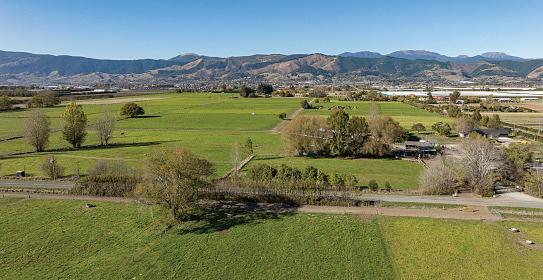
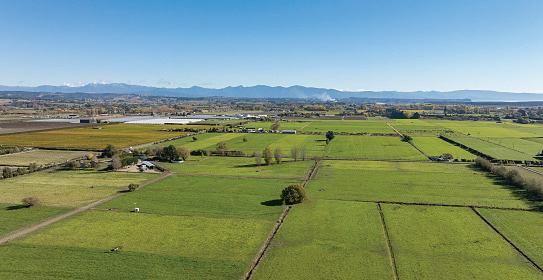
3 2 2
PELORUS SOUND Lot 6 Four Fathom Bay
Hill Block with Consented Quarry
Currently, the property is a functional dairy farm in four titles and the milk produced goes into the award-winning ice cream and frozen yoghurt products of Appleby Farms (Cow to Cone) https;/www.applebyfarms.co.nz/cow-to-cone.
Just on the outskirts of Richmond on the fertile Waimea Plains, the farm has been faithfully farmed by the King family for three generations. However, time moves on, and now with the Waimea Dam operational and providing certainty and reliability of irrigation water, there is now the opportunity for a land use change and the chance to extract more value out of this richly fertile block of land.
Not to be missed is this 80ha (197 acres) bare land block with a State Highway 1 frontage just South of Blenheim. Stunning views of Cloudy Bay can be accessed via the well-formed tracks that lead to the back of the property while close to the highway is a hidden but huge levelled building pad where you could build the shed of your dreams. Approximately 8ha has been levelled along the State Highway 1 frontage that could one day be planted in grapes. To add to the opportunity on this block, a large quarry exists on the southern boundary with a new resource consent to extract gravel until 2038. An additional benefit to an already attractive property.
The property is suitable for horticulture/vegetable development with a fully affiliated shareholding in the Waimea Community Dam.
pggwre.co.nz/NEL39830
pggwre.co.nz/BLE36757
The soils are ideal for a wide variety of horticultural crops with access to reliable irrigation.
Options to purchase all or some of the four titles including a new house:
The whole farm of 57.96ha, 'H Block' 10.7ha, 'C Block' 15.59ha, 'A Block' 31.3ha, dwelling 0.2ha (subject to survey).
A greenfield operation is in permanent pasture. Adjacent to the recent Richmond west Berryfields residential development, just 3km west of Richmond township, 12km southwest of Nelson airport, and a further 4km to Port Nelson.
Contact the agents for further information and an Information Memorandum.
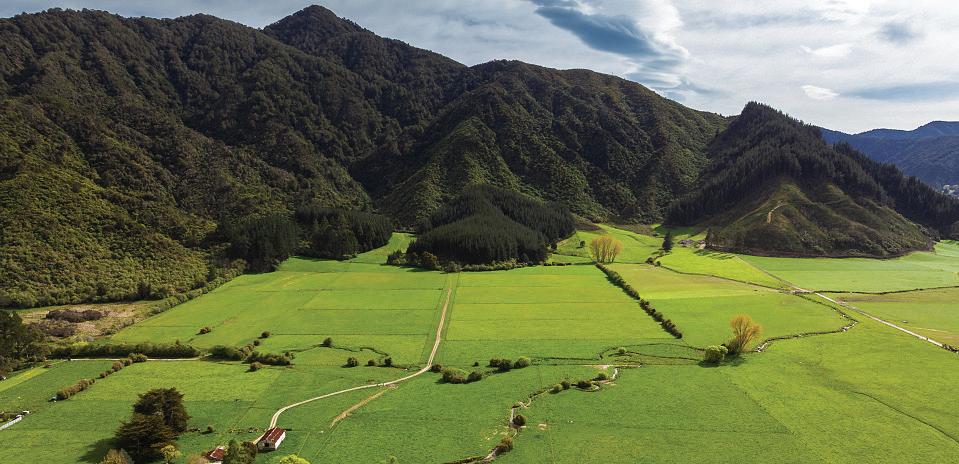


UPPER MOUTERE 225 George Harvey Road
LINKWATER 1437 Queen Charlotte Drive
Quality Lifestyle and Grazing Property
Linkwater Grazing or Lifestyle!
A rare find in the Linkwater area is this incredibly well located 30 hectare grazing block with a native bush boundary.
Within minutes of the beautiful Queen Charlotte Sound this Estate property must be sold.
Lending itself to dairy run-off the property would also make an excellent lifestyle purchase with older farm infrastructure, approximately 20 hectares of flat paddocks, 5 hectares of maturing pine trees, and the balance in native bush.
An easily accessed block that you could make your immediate mark on.
A rarity in the district, 22.4ha on two titles. A flat grazing block of 20.2ha with woolshed, tractor shed, hayshed, and stockyards and a second title of 2.24ha containing the house, pool, four car garaging plus workshop. A spacious 310sqm five-bedroom homestead is set in an elevated position overlooking the farm, facing north for all-day sun, with stunning views of the valley and Western ranges. A large deck and solar-heated pool provide for entertainment and relaxation. The property provides a wonderful opportunity for a family to enjoy the Moutere lifestyle and a property that offers grazing income and a variety of options for the future.
Contact the sole agents Joe Blakiston or Greg Lyons for further information.
Our vendors will sell the 20.2ha bare block, with enquiries over $800,000.
pggwre.co.nz/NEL38263
3 4 ENQUIRIES OVER $1,800,000 GST Inclusive
VIEW By Appointment Only
DEADLINE PRIVATE TREATY Plus GST (if any) No Prior Offers Closes 12.00pm, Friday 1 November 20 Westwood Ave, Blenheim VIEW By Appointment Only

E greg.lyons@pggwrightson.co.nz M 027 579 1233

Secluded Lifestyle and Forest Welcome to Four Fathom Bay, the jewel of the Pelorus Sound bays. This unspoiled bay offers you your own slice of paradise with pristine waters, stunning coastal and sounds views, diverse wildlife, and a mix of native and exotic bush. All this without even mentioning the fishing! Lot 6 stretches from north to south covering an approximate area of 47.41ha. The property sits on the north side and head of the bay with magnificent views scanning up and out of the bay. The property has an approximate MASL range of 10m to 200m. It has 14.6ha of pine replanted in 2019. It also has 11.2ha of regenerated trees, 11.2ha of clear land and the balance is of bush and scrub.
pggwre.co.nz/BLE38802
TENDER
Plus GST (if any) (Unless Sold Prior)
By Appointment Only
Closes 2.00pm, Wed 13 November, 18 Estuary Pl, Nelson
VIEW By Appointment Only
Doug Smith
M 027 543 2280
E douglasjcsmith@pggwrightson.co.nz
Joe Blakiston
M 027 434 4069
Steve Crockett E jblakiston@pggwrightson.co.nz M 027 434 4069

M 021 066 0397
E jblakiston@pggwrightson.co.nz
E steve.crockett@pggwrightson.co.nz


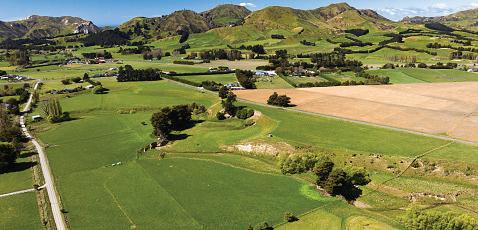
WARD 78 Tachalls Road
Peaceful Country Living....!
Flaxbourne Lifestyle and Bare Land
Easy comfortable living here on this 14.5ha lifestyle property. Approximately 4km from the Tapawera Village, this flat fertile grazing block runs along the edge of the Motueka River. The centrepiece is a fourbedroom home centrally placed and set amongst expansive lawns and established easy-care gardens. The living areas and deck face north for all-day sun. Farm improvements include a three-bay implement shed, stables, and tack shed, plus excellent sheep and cattle yards. A bonus is an irrigation consent to irrigate the property. The Tapawera region is a growing destination with a mix of lifestyle properties, traditional farms, the expanding hop and apple industries, and a new motorsport park.
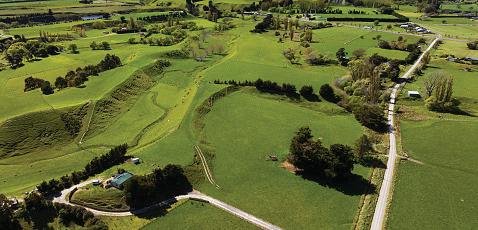
Two appealing blocks on a quiet country road just minutes from Ward township are offered for genuine sale.
Block 1 - 10 hectares on two titles with a near new two-bedroom David Wraight cottage, full farmlet infrastructure, and ready to move into and enjoy a quiet rural lifestyle.
Block 2 - 15 hectares in three titles, productive bare land with two quiet rural road frontages and several building sites. A pleasant stream meanders through both properties. 2 1 2
AUCTION Plus GST (if any) 1.00pm, Wednesday 30 October 78 Tachalls Road, Ward VIEW By Appointment Only
Joe Blakiston
M 027 434 4069
E jblakiston@pggwrightson.co.nz
M 027 579 1233 Greg Lyons
E greg.lyons@pggwrightson.co.nz


The recent conviction of a Murchison farmer and his associated business for illegally clearing almost 10 hectares of native bush has emphasised the need to check and understand the Tasman Resource Management Plan (District Plan) rules associated with an activity before undertaking work. Sentencing in the Nelson District Court in July resulted in significant fines being imposed for charges related to the clearing of indigenous forest at two locations in Maruia Valley. While deductions were ap-
plied for an early guilty plea and no previous record of non-compliance, a total fine of $98,000 was imposed. The Judge said that the offending was a “serious failure” of the defendants to check the district plan provisions.
Whilst the message is clear from the court that it is incumbent on landowners to check the rules before embarking on vegetation clearance, Council recognises that making people aware of where to find the best information can reduce the likelihood of illegal activity taking place and the potential for prosecution. Our advice is “always
check the rules before you do the work”. The rules around the TRMP removal of indigenous forest can be found on the Council’s website www.tasman.govt.nz, search ‘TRMP Part II - land’.




On one of the properties, approximately 4.39 hectares of indigenous forest was cleared between January and November 2020. On the second property, approximately 5.36 hectares of indigenous forest was cleared from between 2 December 2013 and 21 March 2021. In both instances, when using the maximum rate of native forest clearance allowed by the rules in the TRMP, it would have taken between 65 and 80 years to clear.

Sentencing in the Nelson District Court in July resulted in significant fines being imposed for charges related to the clearing of indigenous forest at two locations in Maruia Valley. Photo: Supplied.
Under this permitted activity rule - outlined in section 17.6.5.3 of the TRMP - the area of indigenous forest that can be destroyed or removed is less than 0.2ha (2000 sqm) per site over a 3-year period. In addition to the above rule there may be others to consider around land disturbance and significant natural areas which could be triggered. Therefore, before doing any work on your farm or rural property, we recommend you assess your proposed activity against these rules to make sure you comply with our permitted activity status or whether you need to apply for Resource Consent.
If you have any doubts about whether your proposed work will need Resource Consent or not, or have any questions, please contact our Duty Planner via NRDutyPlanner@tasman.govt. nz. Our Tasman Rural Hub page is also a great resource for finding out the regulatory requirements for your activities.
Nearly half of our native plants and 82% of native birds are currently threatened or at risk of extinction. The removal of indigenous forest from both properties has had a significant adverse impact on the environment, resulting in the loss of valuable habitat for animals like kākā and South Island robin. Exposing the edges of the remaining forest has increased the vulnerability of the forest to pest plants, browsing animals, and dryness. Many native plants thrive in humid forest conditions, and this clearance now allows wind to dry the forest from the inside out risking further degradation or total forest collapse. We are all in this together so let’s get it right.





STUART SMITH
MP Kaikōura
Following a significant flooding event in June this year, the Ministry for the Environment commissioned an external review of the Hawke’s Bay Regional Council’s (HBRC) management of the Wairoa River bar. The report found inadequate management of the Wairoa River mouth led to more flood damage than there would otherwise have been.
Many of our towns and settlements are built on river deltas which are often subject to flooding. Early settlers tamed rivers by planting willow trees to contain them within their banks to mitigate against floods, maintained riverbeds and built stop banks to reduce the risk of flooding. This has been a highly successful strategy until recently, when Regional Councils decided in their wisdom to rewild some of our rivers and take a hands-off management approach.
We saw the damage this can cause in the 2021 Canterbury floods, with weed-choked riverbeds breaching their banks, resulting in some properties being flooded and land lost to the river. I saw this firsthand on the Ashley River, where a few willow trees established an island, and when the waters rose, it redirected the river into the bank, eroding valuable farmland. This was a totally avoidable loss due to mismanagement.
We must accept that we live in a highly modified environment where rivers have been controlled to reduce flooding, which should be front of mind when making management decisions. It is not possible to ‘rewild’ a river as it will simply be invaded by introduced species such as gorse, broom and willow trees. The cost of controlling weed species and allowing gravel to move downstream freely would also likely exceed the cost of sensible management.
River gravel extraction is another example of bureaucracy getting in the way of a good sense. If gravel extraction is managed sensibly, it can lower the risk of flooding and if close to construction projects, it can lower these costs as well. For example, a project to resurface a road in my electorate is having to cart aggregate in a 62 km round trip rather than use gravel in the river adjacent to where the work will actually be undertaken.
Hundreds of unnecessary truck movements on the road costs an additional $100,000 approximately whereas the contractor could apply for a consent at a cost of approximately $20,000, which may well be opposed.
It is time for some common sense to prevail, to end the needless bureaucracy which is adding little more than additional costs. The challenge is that common sense seems to be in short supply.
ELOISE MARTYN
Ticks, a parasite that need blood to survive, are still a tricky parasite to control that can seriously affect animal health. Ticks prefer warmer regions like the Top of the South Island, where an increased presence has been noted in many areas through the Top of the South.
Ticks feed off a range of hosts including mammals, reptiles, birds, and amphibians.They can make animals very sick as well as present a threat to human health, as they can transmit bacteria, viruses, or parasites through their bites.
Ticks can cause anaemia and mortality.
Kim Rowe, who has been farming deer in Stanley Brook near Tapawera for the past 17 years, says tick prevention is key.
“Do not import ticks onto your property it’s really important as you can’t get rid of them. Ask questions like Where is the stock coming from? Do they have ticks? What parasites have these animals had and what have been the control measures?” Kim explains. Kim says that ticks can signifi-
Ticks a parasite that need blood to survive, on a stag. Ticks start off red/brown, they turn blueblack after feeding. Photo: Supplied.

cantly affect the quality of their velvet. “Even if we manage to remove the tick from the velvet, it leaves scars that reduce the overall quality, therefore prevention is key for animal health and quality velvet,” he adds. Kim now uses tick tags on the farm which are ear tags containing slow-release tick control, pyrethroid compound.
“Stags get 2 tags, one in each ear. They are left on for around 16 weeks and then removed so as not to give a sub-lethal dose and start resistance. We have found the tick tags to be hugely beneficial,” Kim says. Ticks spread the cattle disease Theileriosis causing anaemia and death. Signs of anaemia include yellow eyes, lethargy and decreased milk production. “Apply tick control during high-risk periods and any suspected cases of Theileriosis
need to be reported to a vet for testing and treatment immediately,” Kim adds.
Stock is at risk of infection when moved to areas where ticks are present. Likewise, when infected stock are transported, they can spread ticks in the new location therefore quarantine new stock coming onto your farm for seven days, physically examine them for ticks and treat them regardless of findings.
Annette McFadgen from Richmond Town and Country Vet says that if you think you have something that could be a tick take a photo on your phone and email it to your vet who can help you identify it. She also points out that treatment and preventative methods are specific to the animal you are treating so talk to a vet for options.






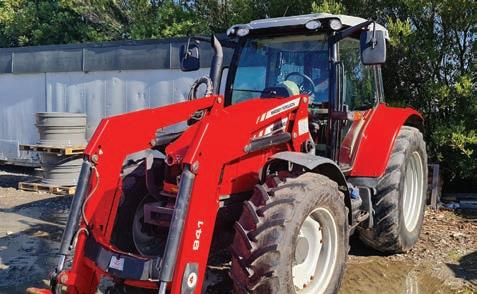
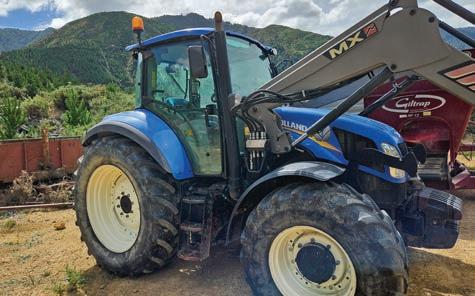

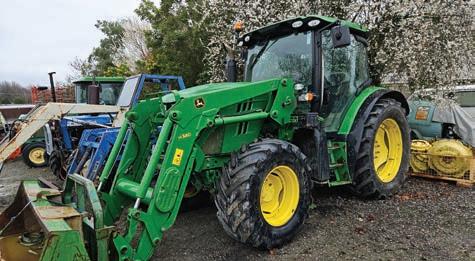


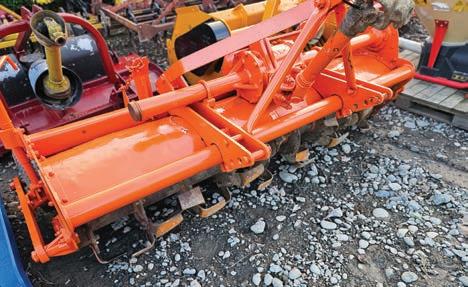


• Iseki 6500 and loader - $12,500
• Massey Ferguson 245 power steering good rubber. Tidy order. New seat and serviced$10,500
• John Deere 5720 Vineyard Spec, medium hours very tidy - $22,500
• 1.8 Rata maxi tool, great order - $2,600
• 55 foot grain auger, 10 inch very good order$9,500
• Giltrap 3 ton tip trailer - $6,000
• Aicheson 3 tyne sub soiler - $4,200
• Heavy duty 7ft back blade hy rams to angle and tilt - $6,500
• Austin 3m HD cambridge roller excellent condition - $4,950
• 9ft cambridge roller, very good order - $2,800
• Hustler front fork lift suit 135 MF - $2,000
• Dual wheels Snap/locks 38” 36” 34” 30” from$2,200
• Silvan 600l herbicide sprayer electric controls$5,000
• Kvernland TLA 6 metre cultivator crumbler$8,500
• Vineyard Sweepers - 2 available
• Mole plough good order - $1,250
• Rata pallet fork euro hitch - $1,250
• Yeoman chisle plough 9 tyne - $2,200
• 2m cultivator - 2 to choose from
• Used cambridge roller rings
• Berti 1.6 mulcher very good order - $6,750
• Berti 1.6 picker mulcher - $5,500
• Ero Roller plucker on power pack all serviced good order - $12,000
• Howard AR 80” rotary hoe - $3,500
• 2000l trailing overow herbicde sprayer hy fold, fully serviced complete with autorate controller$6,500
• 3 metre leveling bar 3pl - $2,200
• Vicon 302 spreader like new - $2,400
• Brevigleri 1 8 mulcher runs up well - $3,500
• 2m Rapier gear drive mower all serviced and ready to go - $6,500
• New 175 slasher, Vineyard mower - $6,000
• Nuibo extendable vineyard mower 1.2mtrs1.75mtrs - $8,750
• Welger RP445 Round Baler, excellent condition, over $15,000 spent on it - $22,500







If you have a title that was in grass but is reverting to native bush we may be interested in buying it. No vehicle access, wetland, steep, gorse, not a problem.
Contact: admin@forestherbs.co.nz






Another two large scale intensive dairy farms in North Otago have been sold recently after receivers were called in. It was no secret locally that there had been both financial and staffing problems for some time. Their failure provides fuel for those opposed to dairying in any form, and that’s a shame because the industry provides food, employment, significant income, and when done well it is the quickest way to sequester carbon.
To those new to the district the contour of the land appears ideal for intensive dairy. The wind-blown soils have a seemingly ideal gentle rolling contour. Dairy cows walk a long way each day and gradual slopes require less energy compared to steeper land. The low natural rainfall has played an important role in the retention of nutrient and soil tests show the best of the country to have naturally high phosphorus, calcium, potassium, and magnesium levels reducing the requirement for expensive inputs.
The demand for a continuous supply of pasture means irrigation is essential and there’s a plentiful supply under most of the country. Land locally remains relatively cheap compared to other intensive dairy areas so why did these enterprises run into difficulties?
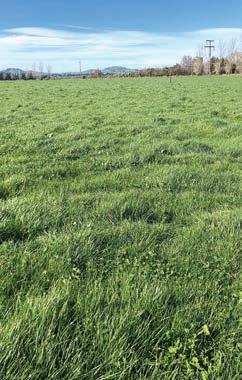
Functional Fertiliser has products that when incorporated into total nutrient programmes increase clover growth and total annual pasture production. Photo: Supplied.
There are several issues that may have contributed and are worth discussing as they have implications for similar operations elsewhere.
The two farms are located on soils that are quite sticky limiting the speed at which water can percolate downwards, and pugging is common under the downward pressure of large numbers of animals confined to small areas. Soil compresses under feet and when it doesn’t quickly regain a structure with close to the ideal 25% air space, pasture production declines. It’s the organic matter in soil that largely determines the amount of nutrient and moisture soils can retain and when synthetic nitrogen is regularly applied the speed at which organic matter is sequestered is compromised.
Surface run-off increases and the conditions for a lift in both nitrate and phosphorus levels in waterways are created although there is no evidence that this did occur on the properties mentioned.
Studies have shown that when nitrogen is fixed naturally by clover, rather than supplied in the synthetic form, the loss of nitrate to groundwater is minimised. Functional Fertiliser has products that when incorporated into total nutrient programmes increase clover growth and total annual pasture production.
To maximise the benefits careful daily management of pasture is essential and there are tech sheets available that provide the information and techniques necessary for best results. It’s not new information and was part of what farmers learnt prior to 1990 when there was still a reliance on clover for the supply of nitrogen.
A change doesn’t mean a reduction in annual pasture production as data from Ruakura Research Station showed permanent pasture production in the Waikato area higher in the 1980’s than it is today. The shift to nitrogen fixed free of charge by clover can be seamless with a spring application of CalciZest resulting in an increase in both pasture and milk solid production over the next six months.
For more info talk to Peter on 0800 843 809.
CalciZest. Applied from a spreader, this is a unique soil improver containing Calcium, Bio Carbons and selected microbes for increased plant growth and optimum soil health.

DoloZest. Also applied from a spreader, Dolomite is a natural soil conditioner. A synergy is created by blending with the unique Zest component which makes it a fast-acting magnesium fertilizers and kick starts the process of building soil humus.
This fertiliser can be used in conjunction with a total nutrient programme. www.functionalfertiliser.co.nz
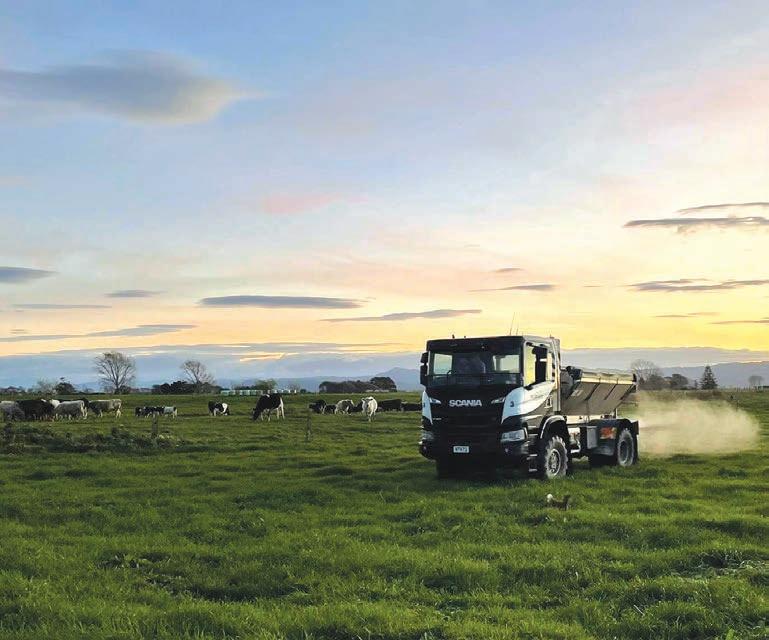

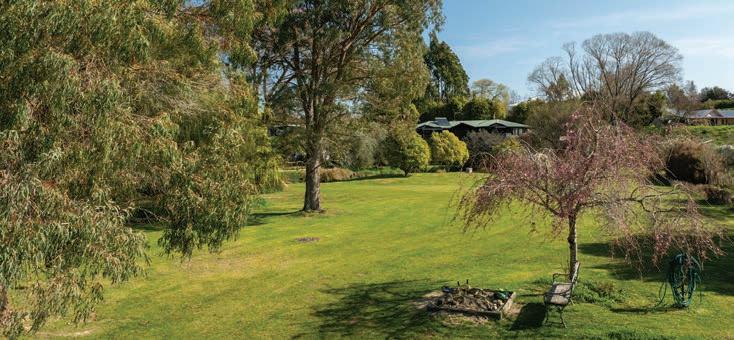
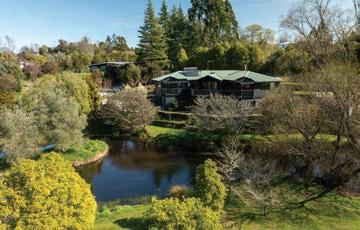

Country Charm - Town Convenience
1376A Moutere Highway, Upper Moutere
Looking for a peaceful country property with the conveniences of town? This charming family home in Upper Moutere could be your perfect match.
Set on 6792 sqm this private, flat piece of land is close to local amenities like the school, pool, shops, and the Moutere Hills Community Centre, which offers sports fields, a gym, and more. The Lockwood-style home features a spacious open-plan layout that flows onto a large wrap-around deck, ideal for outdoor living. With four generous bedrooms (including one downstairs with a bathroom and separate entrance), the home offers flexibility and potential rental income.
The property also includes established gardens, a pond, a thriving orchard, vegetable beds, and a chicken coop. There’s even a concrete shed/workshop with power, perfect for projects or storage. Don’t miss the chance to experience this idyllic country retreat—contact us today for more details or to arrange your viewing.


Elisha Shefford M 021 354 742 elisha.shefford@harcourts.co.nz



The
approximately 166 hectares of well-subdivided and tracked predominantly flat to rolling land, with some gentle hills. Additionally, around 30 hectares are dedicated to established mixed-age pines and Redwoods, presenting potential opportunities for exploring carbon credit options.
The primary 3 bedroom , plus office home has been recently renovated with added accommodation, a fully self-contained cottage is also included.
When it comes to the farm improvements there really are too many to list, including a 105-head Te Pari cattle yards with a crush and loading race on a concrete pad, a 16-aside herringbone milking shed, a woolshed, multiple implement and hay sheds, as well as a workshop and garaging facilities. Comprising five titles, the property holds future development potential.

Toby Randall M 027 233 9170 toby.randall@harcourts.co.nz

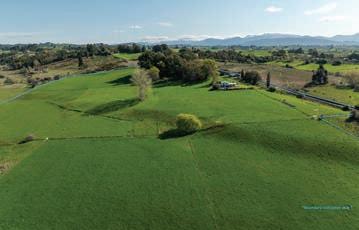

A rare opportunity presents itself with this historic farmlet spanning over 17 hectares of lush grazing land, available for the first time in 120 years. The property features a sturdy family home from the 1970s, offering panoramic views of the countryside. It boasts old oak trees, exotic plantings, and native flora protected by a QEII Covenant, alongside the scenic Moutere River running through. Equipped with excellent infrastructure, including sheds, cattle yards, and a shearing shed, it also benefits from the Dovedale Water Scheme for reliable water supply.
The spacious home includes an open-plan kitchen, dining, and living area, with 3-4 bedrooms, an office, and a rumpus room. With the potential for dual living, it’s a versatile space. The vendors are not GST registered, adding to the appeal of this unique property. Don’t miss out on this piece of history - contact Toby or Elisha today!

Toby Randall M 027 233 9170 toby.randall@harcourts.co.nz

Elisha Shefford M 021 354 742
elisha.shefford@harcourts.co.nz





JACOB LUCAS Nelson Marlborough Fish and Game
Fish & Game staff are actively performing a key role in preserving fish habitat and wetlands, but it’s also been great for trout anglers chipping in for the benefit of nature too. Over the past few years, members of the Nelson Trout Fishing Club have been getting busy helping people and the environment.
The latest initiative has seen the Club run a predator trap line in the Baton Valley. This line was recently established by Farmers 4 Whio, an outstanding local conservation group that runs over 600 traps across multiple catchments in the Motueka Valley, made possible by farmers and landowners who want to protect blue duck (whio) in this area. Fish & Game has been undertaking monthly checks of another trapline for over a year,
and it’s been great to see the Nelson Trout Fishing Club now doing the same on a nearby line.
The Club has also been actively tackling Old Man’s Beard near Haycock’s Bush. A good turnout from the Club at a recent O.M.B event run by the Motueka Catchment Collective was met with such enthusiasm they followed up with a second visit and will look to continue voluntary work here, freeing up important remnant native forest from the stranglehold of exotic pest weeds.
Again, staying within the Motueka Valley, the Club, along with Fish & Game, have recently held a river clean-up day, where members scoured public access points, picnic areas and riverbanks and road verges for rubbish. A similar event was also held in 2023 when a huge pile of unwanted material was taken out of the valley and into landfill. Our recent effort here

thankfully removed less material after the initial cleanup in 2023, nevertheless, our riparian public areas are now looking much better. Anglers have an affinity with
freshwater environments, so any conservation initiatives that are near rivers are always met with eagerness by the Club. Farm clean-up events in the wake of damaging floods in 2021 and
2022 were also a good example of this, where hundreds of hours were spent by Club members and Fish & Game staff removing flood debris and re-instating fences, helping affected farmers and landowners get back operational. This was their way of helping others and saying thanks to farmers for allowing access to favoured trout fishing waters. The Motueka River is arguably the most popular fishery for the Club, being nearby and offering great fishing, so there is always plenty of enthusiasm for conservation initiatives in this valley. It has been fantastic to see the surge in interest from hunters and anglers getting involved in conservation projects across the country. This is an exciting space to be in, and with a large chunk of New Zealanders made up of outdoor users and passionate landowners, it is guaranteed that plenty of great work will be achieved.






The Government has committed more than $2 million over four years to support Sealord’s business development arm to assist in the development of new products from fish waste.
GM Business Development & Sustainability Stu Yorston says the grant from the Ministry for Primary Industry’s Sustainable Food and Fibre Futures fund (SFF Futures) is a huge boost to support work underway to develop and launch garden fertiliser and pet food products made from fish by-products.
“We’ve signed the four-year Fish Waste Optimisation agreement with MPI, and it’s hugely exciting. It’s been a year-long effort working alongside the team at MPI.” Stu says it makes sense to develop new consumer goods from the by-products of Sealord’s sustain-

A fertiliser for commercial application is now being researched that could be used to replace synthetic fertilisers in viticulture, horticulture and even golf courses.
ably harvested fish species.“We utilise over 99% of the fish currently with the main by-product (after filleting) being fish meal, however we want to develop new
products with better yields and higher prices. New Zealand’s deepwater fisheries are a clean, bountiful source of seafood rich in essential nutrients. Sustain-
Whatever our diet and preferences are, we all need farmers three times per day. It is called Breakfast, Lunch and Dinner. Almost everything we eat has its beginning from someone who has tilled the land. The emphasis is on the land, because the Earth is where all food originates from. It is either grown in the soil, comes from animals that graze the pasture that is grown in the soil, or processed from what comes from the animal. Soil is so important, and we must take care of it. We also need to be aware of its natural abilities and how we can encourage the soil to produce. There are two basic ways to produce from the land. The first and most common one is to make the soil work for us. We do this by applying as many elements as we can afford to the soil to make sure we get an adequate result. In other words, we force the land to produce. The other method is to encourage the land to produce.
The diagram on the right shows the basic make-up of soils regardless of where they might be in our country. The 45 percent is the parent material that makes up the soil. It could be a loam soil, a clay soil, or a mixture of many other types. The air portion of the soil is what is required for the root system of plants to breath, for water to translocate and disperse into the soil
and for the soil to be friable. Water is needed to keep the plants alive; a healthy soil needs to have over 20 percent water so that a plant can have sufficient for hydration. The fourth and smallest section of the soil is the organic matter [OM]. This section is the key to the entire soil as it regulates the amount of air and water that is in the soil. The amount of water that the soil contains is largely controlled by the amount of carbon and other material that is contained within the organic matter. Extra organic matter would mean a better water-holding capacity in the soil. What that would mean is that the soil would take in more water during a flood event which in turn causes less flood damage, and going into a drought the plants would have water for longer with less reliance on irrigation. As well as this, because organic matter is usually lighter and has quite an amount of air, the soil will have a natural source of aeration. The organic matter is also the home for microbes and fungi that inhabit the soil and as such is the heart of the soil. The microbes and fungi solubilise the fertiliser in the soil, making for better efficiency, and the capture and release of nitrogen as required by the plant. They also create a dynamic area around the root system which actively seeks out fertiliser elements and brings them into the plant as required, while storing the
ability is at the heart of our business and this business opportunity is just one of the ways we are working smarter in this space.”
CEO Doug Paulin says the seafood industry and the Government are keen to work together to grow seafood export revenue.
“We have a shared goal to continue to grow the sector while caring for the marine environment and being focused on innovative new ways of doing things.”
“Our SFF Futures agreement is a significant step forward for Sealord in developing new revenue streams in a very challenging economic environment. The funding is additional to Sealord’s own investment in people and marketing spend,” he adds.
With the funding con-
firmed, Sealord can accelerate the launch of Sealord Naked, an organic range of garden fertiliser that will be available in all good gardening retailers from midSeptember.
In addition, a fertiliser for commercial application is now being researched that could be used to replace synthetic fertilisers in viticulture, horticulture and even golf courses.
The SFF Futures funding agreement will also enable Sealord to develop a range of pet food ingredients for pet food manufacturers to be launched in 2025, as well as produce Sealord branded pet food in 2026.

rest in a form that is held in reserve for future use. There are many other ways that microbes and fungi help and aid plants, not only to survive but to thrive.
For more information, please contact us on 0800 337 869 or visit www.fertnz.co.nz





KEN STRUGNELL
The question I get asked most often is where are the electric Utes Jacinda promised five years ago? Well firstly, there is no such possibility of having a pure electric or Hybrid Ute with the same ability as petrol or diesel can provide, physics prove it. The Kia EV 9 SUV has a battery weighing nearly 700kgs of the total 2670kgs, leaving only 330kgs approx for passengers and cargo while still having a Gross Vehicle Mass [GVM] of less than 3 tonnes.
So, a similar Ute would allow no towing or goods in the tray, with more than three people on board. Overseas the start-up Rivian Ute and Tesla’s Cybertruck are pure electric, though with a GVM of nearly 4000kgs. They can tow up to 4500kgs but both figures relegate them into the truck class two category in NZ, while towing lifts them to well over 6000kgs Gross Combination Weight [GCM]. So now, as back then, there are still no real 4WD Electric or Hybrids available. Okay, Toyota has launched a 48-volt mild Hybrid,

though it won’t run on electrons only. Ford has long promised a plug-in Hybrid Ranger and Mitsubishi have hinted the new Triton may be offered with a Hybrid system, though none have even been produced for sale anywhere yet. The LDV electric Ute has been on the market for nearly four years. It has received mixed reviews and limited sales here, probably due to lack of payload and range, or 4WD option. At this year’s Fieldays in Hamilton, BYD [Build Your Dreams] teased us with a pre-production model of their upcoming Hybrid Double-Cab 4WD Ute named the Shark. Given the aquatic theme, names of other BYD vehicles like the Seal and Dolphin, I guess the name is
in keeping with their ethos. Personally, as a child of the 60-70’s the recollection and terror the Jaws movies engendered then have stayed with me, so Sharks are to be feared!
Not so, for the fearless enthusiastic Ateco Co. team at the Fieldays launch, who waxed lyrical about their latest offering on display. Sources since have told me that much of what was evident there, has been tweaked or changed markedly.
As the image above shows, it is a bold design echoing the Ranger, though slightly bigger overall.
There are hints that it will publicly launch later this year, though past experience would suggest 2025 more likely. However, as BYD is now known for very affordable and reliable vehicles, they will want to beat Ford and probably GWM onto the market.
The Shark will be a plug-in Hybrid, so subject to the current ½ priced RUCs with an expected range of 70km on battery alone.
Recharching done on the move via a 1.5 litre Atkinson cycle 4-cylinder turbo petrol engine,
likely to be quite economical, so I was told! The tow rating is claimed to be 2500kgs braked, well down on the market 3500kg standard. Cargo in the tray may be around 500kgs, if the battery weighs in under 350kgs, allowing for a theoretical vehicle mass of 3500kgs, well north of our current diesel offerings. The interior is as expected dominated by tech and large screens, though the 4WD systems and probably air suspension will provide great off-road ability. Space is generous front and rear with lashings of leather, heating and massage functions.
Information is scant or embargoed despite me knowing the team at Ateco, suggesting there is still specification work being done to make the Shark suitable for NZ conditions. That said, it is likely to find a market here as BYD have a knack of pricing to make vehicles attractive to their intended sector.
Don’t however expect Ute-topia, it won’t exist until battery technology cuts weight to about a third of the present available units.



Dairy processing company Miraka has launched New Zealand’s first green hydrogen dual-fuel milk collection tanker to reduce milk collection transport CO2 emissions. Miraka, a Māoriowned, Taupō-based dairy plant, already has one of the world’s lowest manufacturing carbon emissions footprints, emitting 92% less CO2 than traditional coal-fired dairy factories.
The FH16 700 Volvo green hydrogen-diesel dual-fuel milk collection tanker is the first of its kind for milk collection in Aotearoa New Zealand. It will cover approximately 165,000km annually. It can haul 58 metric tonnes and requires two hydrogen refills daily.
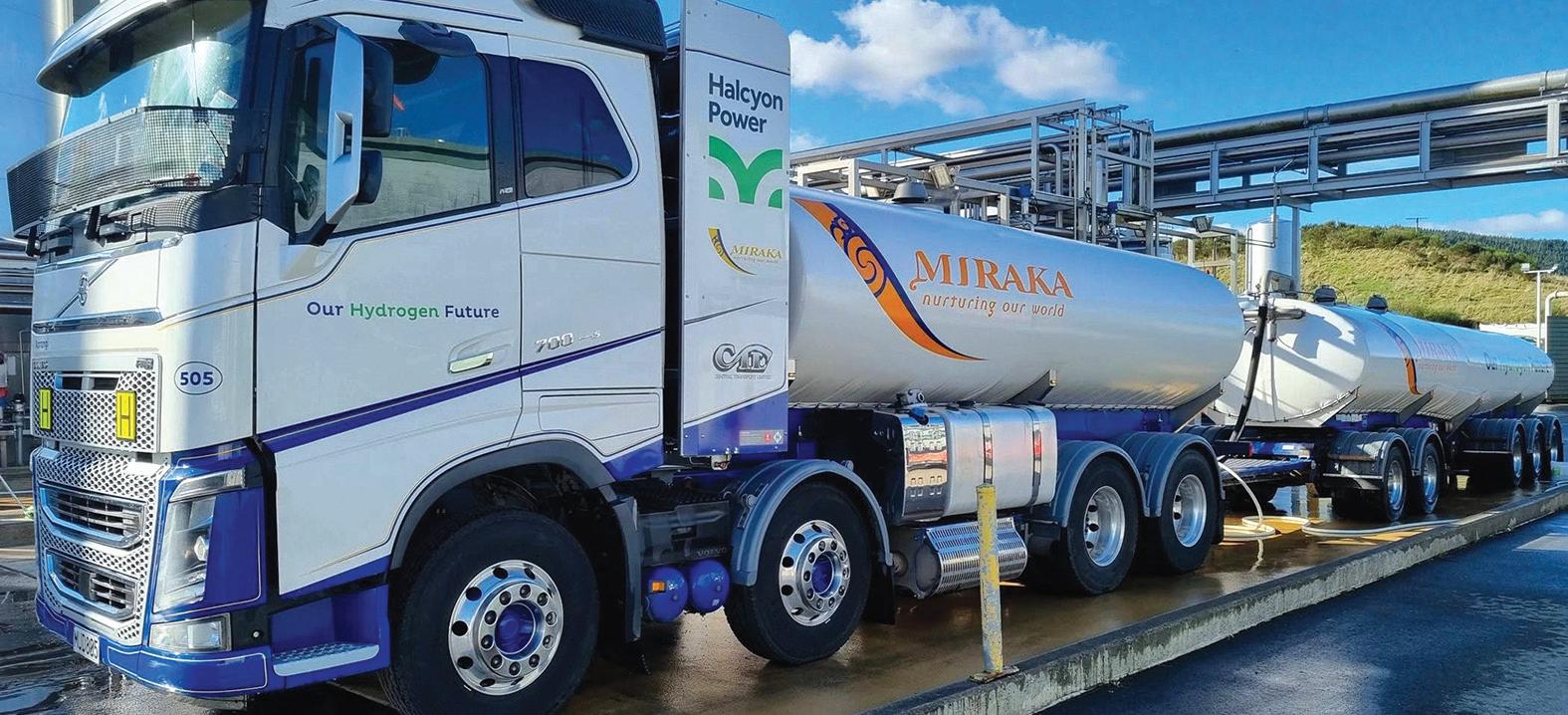
Miraka CEO, Karl Gradon, said, “Although hydrogen-powered vehicles are still an emerging technology, we believe green hydrogen represents the most environmentally appropriate energy source for heavy freight. Our green hydrogen dual-fuel tanker is designed to reduce milk collection CO2 emissions by approximately 35%per vehicle, benefitting te taiao, the environment and our community,” he said.
Miraka, Central Transport and Halcyon entered into a partnership a year ago, establishing a Rural Hydrogen Hub, which Gradon said one day could be expanded. Tūaropaki Trust, a cor-
nerstone shareholder in Miraka, provides geothermal energy and steam for the Miraka dairy plant through its Mokai Power Station. Under a joint venture partnership with Japan’s Obayashi Corporation, Tūaropaki established Halcyon Power, New Zealand’s first commercial-scale green hydrogen plant. Halcyon will supply the green hydrogen for the new tanker from their facility, which is adjacent to the Miraka dairy plant.




ELOISE MARTYN
For decades students at Marlborough Boys College have had the unique opportunity to explore careers in the forest and wood processing industry with a practical, hands-on forestry course.
“Each year we have around fifteen to twenty boys participate in the forestry course. There is only one other college that offers this opportunity so it’s pretty unique,” Marlborough teacher of Forestry, science, and agriculture Rebeccas Kane explains. The year-long course covers industry health and safety, environmental requirements, the growth and processing of commercial forests as well as the use of chainsaws and training requirements. The course is heavily supported by Top of the South Wood Council who say they are
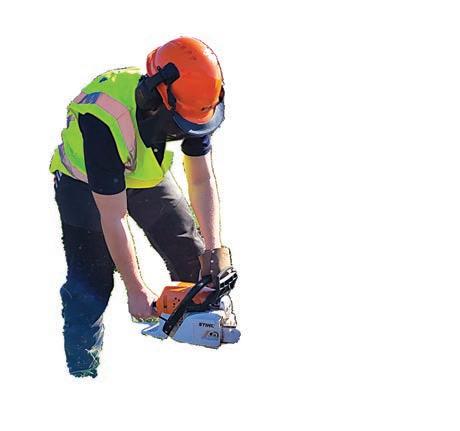

proud to supply funding for equipment, workbooks, and support out-of-class learning and pathways to jobs in the forestry industry.
This year, the team has acquired practical chainsaw skills by cutting slab wood for the local Lions group’s community fundraiser and
will then progress onto to sawing felled trees at the College hut.
“It’s great to have the opportunity to give back to the community while also learning about operating chainsaws and saw safety,” Rebecca adds.
Top South Farming Monthly heard from some the current course participants. Josh Flyn said ““I took the course so that I could learn how to use a chainsaw correctly, and it was a practical hands-on subject.” While Tom Robinson explained that he enjoyed the course because “It was hands-on. I have taken the chainsaw apart and learnt about the parts inside it.”
The group has also been involved in planting community trees which gives an introduction to tree planting and opens up conversations about tree care and life span.
PF Olsen
On September 4, the New Zealand Government’s quarterly NZU (‘New Zealand Unit’) auction failed to attract any bids for the second time in a row. This was due to the secondary market consistently trading well below this year’s $64 auction floor price since the first auction in March. The market, which has been quite active in recent weeks, closed at $61.95 on the eve of the auction, so just over $2 shy of the floor price. Buyers saw no point in bidding at the floor price or above when they can buy units for less elsewhere. The volume available for purchase at the last auction of the year on December 4 has now increased to just over 11 million units, not counting the cost containment reserve volume of 7.7 million units. Any unsold units will not carry over to 2025, when the floor price will increase to $68.
(The NZETS introduced a special type of currency called a ‘New Zealand Unit’ (NZU). Each NZU stands for one metric tonne of carbon dioxide or an equal amount of other greenhouse gases.)



On the 6th of September, the New Zealand Institute of Forestry (NZIF) hosted its prestigious annual awards dinner in Nelson, recognising outstanding achievements within the forestry sector. The awards celebrated a diverse array of contributions, from grassroots initiatives to impactful policy development and academic leadership.
The Kirk Horn Award, one of the most esteemed honours in New Zealand’s forestry sector, was presented to Bill Liley. This award recognises exceptional contributions to forestry and is steeped in history, commemorating the legacies of Thomas Kirk, a prominent botanical explorer, and Captain Inches Campbell-Walker, New Zealand’s first Conservator of Forests.
NZIF President James Treadwell praised Liley, describing him as “down to earth, highly professional, and a fierce intellect.” In addition to his impressive professional career, Liley continues to manage his own forest and op-
erates a small sawmill to process timber from his land.
The New Zealand Forester of the Year award, a highly coveted recognition, was awarded to John Hura for his exceptional contributions to the forestry sector over the past year. Hura played a pivotal role in leading one of New Zealand’s largest salvage operations following Cyclone Gabrielle, ensuring environmental sensitivity and high standards of health and safety throughout the process. Treadwell highlighted Hura’s leadership in Māoridom’s forestry industry, stating, “His strong morals and ethics have earned him respect across the industry. His refusal to bow to political pressure has only enhanced his standing, both within Māori and non-Māori forestry circles.”
FRESTRA Young Forester of the Year: In a historic moment for the industry, the inaugural FRESTRA Young Forester of the Year Award was presented to Sarah de Gouw. This award acknowledges a young forester who has demonstrated extraordinary dedication to both their profession and community, reflecting the values of
Brooke van Velden, Minister for Workplace Relations and Safety, has launched the consultation process to reform health and safety. The scope of consultation is focused on the purpose and performance of the work health and safety regulatory system. Safetree
In 2013 forestry’s safety performance was so bad that we were killing people at a rate of one per month for that entire year. Following the 2014 Independent Forestry Review, we now find that in 2024 our safety performance has improved dramatically With that in mind, here are six things that forestry’s experience over the last decade shows are essential to supporting improvements in health and safety performance.

awarded to Chris Ensor of Nelson for his unwavering commitment to sustainable forest management. This award recognises individuals who embody the principles of sustainability in policy, planning, and practice, while also actively engaging with the public to promote forest conservation. Treadwell highlighted Ensor’s selfless dedication, noting, “His commitment to sustainable management is so strong that he frequently volunteers his services, despite his salary barely covering his costs. His actions are a testament to his intent to improve the forestry sector for the benefit of all.” The forestry industry continues to play a vital role in New Zealand’s economy, with its contributions extending beyond economic growth to include carbon capture, biodiversity, recreation, and overall well-being.
FRESTRA and Future Foresters. De Gouw was commended for her remarkable efforts in raising forestry awareness, particularly through outreach programs in local schools. She has become a passionate advocate for forestry, engaging with students and teachers alike, and inspiring the next generation with activities ranging from reading forestry books to operating drones to showcase the sector’s opportunities.
• We need a burning platform to compel positive change
• We need leadership with a mandate to coordinate collective action
• We need engagement with an effective Regulator
• We need to empower industry to innovate and find solutions
• We need to support training and competence
• We need to recognise that legislation is an enabler, but people make the difference
To make a submission on the reforms head to: http://www.mbie. govt.nz/have-your-say/workhealth-and-safety.
Submissions are due by 31 October 2024.
The Prince of Wales Sustainability Cup, established in 2017, was

“We are fortunate to have such a skilled and dedicated group of professionals who set the benchmark for excellence in our industry,” Treadwell said. “The NZIF is proud to celebrate and champion the achievements of this year’s award recipients.”

With 25 years experience in the industry the Tasman Forest Management (TFM) team offer services in:
• Forest and woodlot harvesting
• Domestic and Export Log Purchase
• Forest Establishment
• Emissions Trading Scheme advise and management
• Forest Valuation
• TFM are part of the Forest Management Group with offices throughout the South Island, Hawkes Bay and Southern North Island

MARCUS MUSSON
Director Forest360
Spring has sprung, lambs are frolicking, daffodils are blooming, and the feeling of warmer temperatures and better times is hanging heavy in the air. Unfortunately, like the frolicking lambs, logs are still worth bugger all in the export market with September prices flat with August at around $113/m3 for A grade. However, that feeling of better times is likely to come to fruition for logs (but probably not lambs) as shipping rates ease and in-market sales prices increase, albeit very marginally. If you run the abacus over what October might look like you get a number in the early $120’s/m3 for North Island ports. This increase will be as welcome to forest owners as Darlene Tana’s departure from parliament will be to the Greens (and everyone else).
On port log inventories in China have increased by over 200,000m3 in August to 3.4million m3 as supply has been stronger than expected, however, offtake has also recently increased by around 10,000m3 per day to 60-65,000m3 per day which should help balance the books. The NZ:US exchange rate has continued to be strong at $US0.62 which has not helped pricing levels. As a rule of thumb, every cent appreciation in the $NZ takes around $NZ3/m3 off the bottom line.
There’s still no change in the residential construction activity in China and there’s not likely to be for a while as there’s currently enough empty new housing stock to rehome the entire Chinese population and still not touch the sides.
Construction numbers at home don’t look terribly flash either with consents down 22% compared to 2023. While we don’t
have the ridiculous over supply issues that China does, we do have other issues. Construction Minister, Chris Penk said recently that it was “too hard and too expensive to build” and committed to cutting red tape and lowering building costs. This will be great news for homeowners as anyone that has dealt with building consents will understand the cost that bureaucracy adds to a build

Domestic log demand has, however, remained relatively stable despite the current trading conditions facing merchants. The electricity crisis may have wins for those holding NZU’s as generators throw coal (imported Indonesian coal that is) and gas into boilers as fast as they can. This has generated a 170%


increase in emissions from the same period last year and the highest total emissions level since June 2021. This increase in emissions will chew a hole into the NZU stockpiles held by generators which will need to be replaced at some point. Interestingly, coal-based generation emissions increased 265% in the second quarter of this year which is an increase of around 500,000 tonnes of CO2 - something to think of as you’re driving your EV to work, scowling at anyone with an exhaust pipe while believing you’re saving the planet.
The latest NZU auction failed without bids high enough to clear the auction floor price of $64/ NZU. Following this the NZU price reached a five-month high
of $62.25 before settling back down into the mid $61 territory. Total NZU holdings have now dropped to 144 million, which is the first time below 150 million since mid-2021. If you were a betting person, you’d be looking at holding your NZU stash. All in all, there’s a bit of light at the end of the tunnel, albeit a candle flickering in the wind. Export prices look to be firming, summers’ coming, and things will dry out. Pricing will be very unlikely to reach the peaks of previous summer rally’s and in terms of supply, we definitely don’t need a big price spike related supply slug to hit China later this year. So as summer progresses, help the industry out - get out there and build that deck, crack on with that house extension and put new palings on the fence. Our farming cousins would appreciate it if you could also chew on a lamb chop while doing it


13 yrs
Meet Levi, a dedicated dairy farmer based in his hometown of Karamea on the picturesque West Coast. In this article, I delve into exploring how he transitioned from his earlier life to becoming a central figure in our local dairy industry. Levi’s story is one of passion and perseverance, rooted deeply in his experiences and the challenges he has overcome. As
my dad, he has not only shaped my understanding of farming but also offered invaluable lessons about his hard work and commitment.
Levi gained his initial skills from a local Karamea dairy farmer named John Hyndman, who provided invaluable lessons on farming, focusing particularly on animal health and pasture measurement. John’s guidance included practical insights into managing feed and maintaining the well-being of livestock.
One of the most crucial lessons John imparted was the importance of consistently monitoring the cows, whether they were in the milkshed or out feeding in the paddocks. This vigilant approach, ensuring that each cow’s needs are met, and any issues are promptly addressed, has become a fundamental
practice in Levi’s own approach to dairy farming. This acquired knowledge and discipline continue to influence his daily routines and contribute to his commitment to high standards in animal care.
Levi says that one of the downfalls of dairy farming is working outdoors in cold, wet clothes, battling boggy paddocks, and dealing with floods that break down fences. However, Levi overcame these moments by thinking about coming home to a nice warm bed and hot food ready for him after a cold day out on the farm.
On the flip side, Levi says farming has brought him many proud moments, including achieving his dairy Level 4. During the 10 years he has been in the farming industry, he has witnessed significant development and technologi-
cal changes, such as electronic collars that monitor cows in heat and health, pasture measurement by satellites, and more advanced milking sheds. While the farm he works on now doesn’t use this technology, other farms he has worked on and local farmers and friends that Levi connects with do. Overall, Levi is a very ethical
and hard-working dairy farmer who always makes things easier for the next person, takes care of the animals with much passion, and is very serious about his job.
Levi enjoys dairy farming as part of his daily life and looks forward to a future that involves farming in some shape or form.
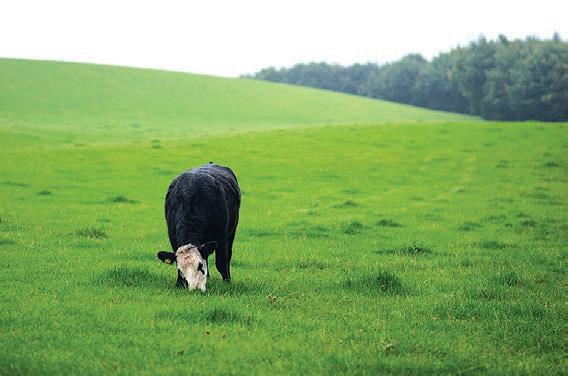
guidance of trained staff.
After four years, herds in the West Coast settlement of Hari Hari are now TB free. To protect the herds, further work is needed to ensure possum and other predator numbers are kept low enough to eradicate TB in the area.
In this outbreak, there were a total of 17 herd breakdowns of infection, making up a quarter of the total herds in the small farming community.
“It’ a significant step for the community of Hari Hari, neighbouring areas in the West Coast region and the national TBfree plan”, says OSPRI Chief Executive, Sam McIvor.
“Getting rid of TB in their herds is a huge achievement that takes a systematic approach and coordinated effort over many years. It
TB freedom in Hari Hari cattle brought the total number of TB-infected herds across the country down to 12, the lowest number on record.
takes a team effort, and we work with the community and partner agencies to design and implement a disease control response plan that is tailored for their area.” Over the past 30 years, there have been outbreaks in the farmland of Hari Hari following a 5 – 10-year cycle.
Prior to the 2019 outbreak, there were no infected herds for four years.
As part of the disease control plan, major work carried out included regular herd TB testing and significant amounts of possum control on farmland and surrounding areas of Hari Hari and the Waitaha Valley, using both ground and aerial possum control methods.
“Our surveillance of wildlife in the surrounding native bush shows us that the infection problem may remain in the Upper Whanganui,

and that we do need to do another round of aerial treatment there to clean up the remaining infection, whilst also maintaining low possum numbers across the whole area.
“TB is a resilient bug, and we need to keep our foot on the pedal to wipe it out.”
Over the coming years, disease
control work will continue with regular monitoring and testing of livestock and wildlife for any signs of TB.
TB freedom in Hari Hari cattle brought the total number of TB-infected herds across the country down to 12, the lowest number on record. This compares to 1995 when there were
an estimated 1,700 TB-infected herds.
“The number of infected herds may bounce around a little bit but importantly, it is trending down overall. Ongoing biosecurity vigilance and ensuring NAIT records are up to date are critical ingredients in continuing our progress.”

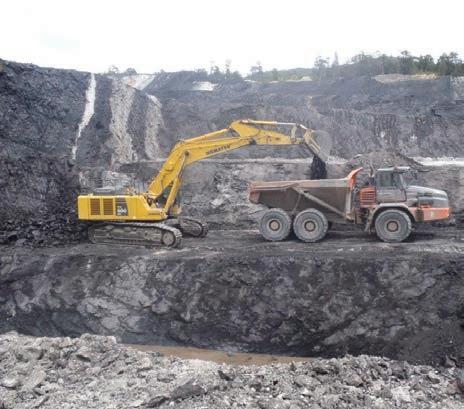

TONY ORMAN
Marlborough Federated Farmers has backed Landcare Research in a move to attack Barberry by a twopronged bio-control measure with a rust and weevil. At the recent meeting of Marlborough Federat-

ed Farmers, Vice President Richard Dawkins said Barberry is a huge issue in Marlborough and it needed as many tools as possible to fight it.
Landcare Research is currently preparing an application to the EPA (Environmental Protection Authority for release into New Zealand of the DBB rust (Puccinia berberis-darwinii) which it plans to submit to the EPA in early December. The application will also include a re-application for the release of the Darwin’s barberry flower weevil (Anthonomus kuscheli). The release of this weevil was approved by the EPA in 2012, but the approval has since lapsed.
Darwin’s barberry, a 5-metre-tall spiny shrub, is native to Chile and Argentina, and was first introduced to New Zealand as an ornamental shrub in 1946 and is now
common from central North Island to Stewart Island.
“Darwin’s barberry is viewed as an expanding threat to environmental and economic values as it is still spreading. It invades farmland, forest margins, light gaps in disturbed or remnant forests, roadsides, and scrubland, out-competing native plants,” said Landcare Research.
President Evan White’s monthly report highlighted a productive meeting with Climate Change Minister Simon Watts, including carbon farming involving the planting of monocultures of pine trees.
“Pine trees are being planted on sheep and beef farms that should be producing food,” said Evan.
Upper Waihopai valley farmer Geoff Evans said once there were 12 working farms
in the upper valley, now there are about two with previous farms going into forestry including carbon farming.
Membership
There was discussion on the decrease in farm numbers as land was planted in carbon sequestering pines which in turn, impacted on Federated Farmers membership.
“The farms aren’t there in past numbers and that’s a major factor in the national sheep flock going from 70 million in the 1970s to less than half today. That impacts on Fed Farmers membership too, as farms are fewer,” said Geoff. In the Meat and Wool Section Report Cath Baker reported that there had been a “huge reduction” in national sheep numbers overall. One positive aspect was the slowdown in Australian lamb production which could result run better export returns.
“Beef exports get a gold star,” said Cath Baker. “Average export value is well above the 2023 pricing as well as the 5-year average since May this year. This has been mostly driven by high US demand. This has certainly helped farmer confidence and a welcome injection of a positive note to the farming outlook.”
Hamish Morrison reported the winter with mild temperatures had been an excellent one for dairy farmers. There is optimism over returns with Fonterra updating the forecast milk price with a mid-point of $8.50 and ANZ updating to $9kg/MS for the 2024-5 season. If this materialises it’ll be a huge boost for farmers who have been forced to trim budgets over the last couple of years.




TONY ORMAN
A strong call has been made for alternative routes other than state highway one between Seddon and Blenheim.
The call came at a recent meeting of Marlborough’s Rural Advisory Group by Bev Pitts of the upper Awatere valley, who said the recent highway closure due to a truck rollover and “frequent road crashes” on the Weld Pass section of the highway needs to be addressed.
“Something must be done to provide alternative Taylor Pass and Redwood Pass routes, to ensure traffic can continue,” she said. “Road crashes on State Highway 1, between Seddon and Blenheim are frequent, and Redwood Pass and Taylor Pass, are not available for all traffic
to use, such as, B Trains, Trucks and trailers, carrying stock, logs and other general goods, long campervans, and wider ma-
one, and southbound the other.
Molesworth /Hanmer, in summer, and locally to avoid the density of traffic on SH1.”
Something must be done to provide alternative Taylor Pass and Redwood
Bev Pitts
chinery loads.”
Having the two routes, the Taylor and Redwood Passes available, for north and southbound traffic is an option and also for the two narrow roads to have northbound traffic using
“However, widening Redwood Pass to enable trucks and trailers, better and safer access, would negate delays especially those meeting ferry times in Picton. This route has been suggested as the best by transport firms, with easy gradients and no river fords, compared to the Taylor Pass Road,” said Bev.
On the Redwood Pass, advice is that one particular corner if widened, would allow trucks and trailers to use it.
“However, Taylor Pass would benefit from some serious widening of blind corners, and maybe stop` hoons `using the road as a racetrack and resulting frequent traffic mishaps. It is well used by cyclists en-route to and from
The current alternative route advertised, when SH1 is closed, through the inland road, via Lewis Pass, Murchison and Wairau valley, is expensive in time, fuel and animal welfare, when both Redwood and Taylor Pass routes are currently unusable to larger traffic.
The meeting decided to write to the Marlborough District Council, Marlborough Roads, Land Transport NZ and Kaikoura MP Stuart Smith, NZ First local MP Jamie Arbuckle, the Minister of Transport and others calling for upgrades to the two alternatives to the state highway.

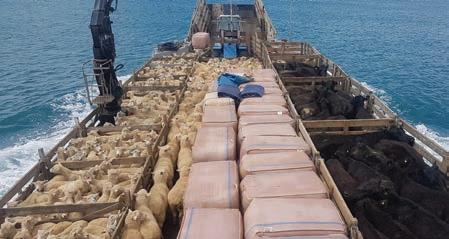
We can deliver or collect just about anything, including building supplies, gravel, fertilizer & stock. We also look after swing moorings.
Servicing the entire Marlborough Sounds for over 100 years
South End of the marina, Havelock • P: 03 574 2434 • E: info@jbs.nz
www.jbs.nz
It’s the fun-filled family day out you’ve been waiting for!
Come and soak up the atmosphere from 9am till 5pm Kids under 16 FREE • Adults $10
• Clothing, boots, outdoor gear
• 4WD’s tractors, boats, bikes
• BBQ’s and tents
• Yummy food stalls & coffee
• Exciting rides
• All-day entertainment
• Sheep, cattle, poultry, pigs & pets
• Wood choppers
• Creative handmade competitions
• Terrier race
• Grand parade
• Equestrian & dog trials (Fri & Sat) THANK




Imagine pedalling along the most remote part of Tasman’s Great Taste Cycle Trail, soaking in the rivers and mountains, when suddenly you stumble upon a hidden gem. Welcome to Lublow’s Leap, the newest addition to biking adventures up the Baton Valley.
Recently opened, Lublow’s Leap is an oasis for cyclists, offering a perfect vantage point to admire the foothills of Kahurangi National Park and, if you’re lucky, catch a glimpse of the elusive Whio, or blue duck, from the brand-new Baton Valley swing bridge. The remote area is full of expansive skies, towering mountains, and meandering rivers with a growing population of Whio – thanks to the efforts of Farmers for Whio, a local community group dedicated to protecting these precious birds. Lublow’s Leap was crafted by Richard and Fiona Lublow, the generous souls behind Baton Run farm stay. It’s a place to stop and rest and learn about the history of the Baton Valley and the community conserva-
tion efforts taking place. Step inside the stylish shed adorned with chandeliers and an antique tractor, and you’ll find enlightening information panels and a pop-up refreshment shop.
Since 2020, Farmers for Whio has been hard at work in the Baton Valley, deploying around 600 traps to safeguard whio nests and chicks from invasive predators. From ferrets to feral cats, every threat is diligently monitored and managed by local community volunteers.
During critical periods like moulting and nesting, extra care is provided to ensure the birds’ safety. According to Barry Burger, Trapping Coordinator for Farmers for Whio, the group’s efforts have almost covered the entire Bolton Valley. The result? More frequent sightings of whio and a growing appreciation for these remarkable birds among locals and visitors alike.
So, the next time you’re planning a cycling trip, consider taking the scenic route up the Baton Valley. With breathtaking vistas, heartwarming hospitality, and a touch of conservation magic, it’s an adventure you won’t forget.

• Pasture Reclamation & Land Clearing
• Winch-Assisted Hill Work
• Stump-Grinding
• Earthworks
• River Works
• Pond & Dam Formation
• Site Preparation & Building Pads
• Forestry Work & Slash Management
• Driveway & Road Formation
• Demolition



Recently opened, Lublow’s Leap, the most remote part of Tasman’s Great Taste Cycle Trail, up the Baton Valley, Tapawera, the valley runs roughly parallel to the eastern edge of Kahurangi National Park. If you’re lucky you can catch a glimpse of the elusive Whio (Blue Duck).
Photos: Andrea McLeay.

Exceptional results in minimal time
Palmer Earthmoving Ltd, a family-owned and operated business by Rebecca and Nathan Palmer, has been serving the Top of the South Region for many years. The company provides a wide range of earthmoving services to areas including Tasman, Motueka, Tapawera, and St Arnaud. They are also available for projects in Marlborough, Golden Bay, and the West Coast, ensuring their clients across the wider region receive top-notch service. As a small, hands-on company, Palmer Earthmoving Ltd prides itself on delivering reliable, high-quality results to residential, commercial, and agricultural projects and clients.
Nathan has been operating diggers for over 20 years and brings a wealth of experience to every job and the recent acquisition of a new stump grinder has expanded their already wide list of services.
Their expertise spans an impressive variety of projects, including general earthworks, forestry work, driveway and road forming, land clearing, pasture reclamation and pond and dam formation. Nathan’s specialised skills also extend to winchassist work on steep hillsides, ensuring a smooth and professional finish on challenging terrains. His reputation for delivering exceptional results in minimal time has earned praise from clients across the region.
One notable success story involved a farm owner hesitant to use Nathan’s recommended winch-assist machine, for additional stump-grinding and land clearing, due to cost concerns. However, the results exceeded expectations, as Nathan’s productivity and land improvement efforts proved to be a valuable investment, reclaiming more usable land for the farm.
Palmer Earthmoving Ltd take safety seriously and, coupled with a commitment to customer satisfaction, sets the company apart in the region. They have a comprehensive Health & Safety Manual, and for each job, a Site Safe Specific Plan is created and emailed to clients before work begins. Nathan also operates a Work-Alone unit connected via satellite, ensuring he is monitored throughout the day, adding an extra layer of safety and peace of mind. Whether it’s earthworks, forestry services, pond formation, or land clearing, Palmer Earthmoving Ltd can tackle any job, large or small. To discuss your project, you can reach Nathan at 0275522980 or email info@ palmerearthmoving.co.nz for a free estimate. The company promises a job well done, and their long list of happy customers speaks to their reliability and skill.
Business Update. Advt.

Tasman District Council
Central Government is currently reviewing the Freshwater Farm Plan (FWFP) regulations. These regulations do not yet apply in the Tasman District and the future timing of when they apply will be determined by the review process.
The announcement made by Central Government on 3 September, that the legislated rollout of FWFP will be paused, relates to the regions where the regulations already apply (Waikato, Southland, West Coast, Otago and Horizons).
This formal pause, for those currently subject to the reg-
ulations, provides some certainty around existing timeframes for farmers within those regions while the review is underway. Pausing the rollout before the end of this year allows everyone a chance to take stock and consider changes to make the system more workable and cost-effective.
We appreciate that this brings some uncertainty. What is evident is that the FWFP regulations themselves will remain, and we wait for further direction from Central Government on the final form they will take.
There is a lot of great work happening within catchments to manage the risks to fresh-
water. Farmers and catchment groups are being encouraged to keep up with their efforts in anticipation of the FWFP rollout following the review.
Our Soil and Land Use Team, through their Catchment Facilitators, will keep you up to date with news and events. They are presently working behind the scenes collating catchment information and ensuring everything is in place for the successful development of these plans. Further information is available on the Tasman Rural Hub – tasman.govt.nz/rural-hub.
If you have any questions, contact a facilitator at ruralinfo@tasman.govt.nz or phone 03 543 8400.
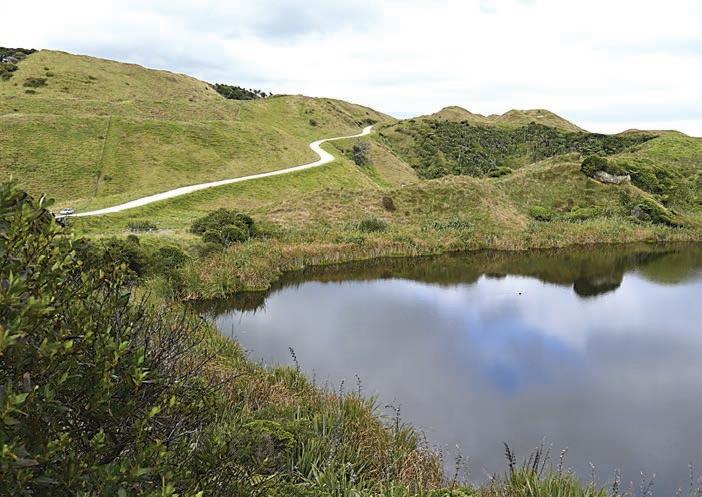
‘Groggy’ sheep farmers need to weather economic hangover
ELOISE MARTYN
The upcoming season looks particularly challenging for sheep farmers, according to Beef and Lamb New Zealand’s latest forecast.
This, despite a modest improvement in global red meat demand, farm profitability, particularly sheep farming, is set to decline further.
The forecast projects a 7.4% drop in average profit to $45,200 per farm, with rising costs outpacing revenue growth. It highlighted that a 1.8% rise in expenditures would offset the anticipated 1% increase in revenue.
“Low demand from China is expected to maintain low
sheep meat prices while the markets for North America and Europe are expected to provide stable support for lamb prices,” Tapawera sheep farmer and meat and wool chair for Nelson Federated Farmers Kerry Irvine explains.
The projected lamb price was $6.79 per kilogram carcass weight or $130 per head, marking an 8.2% decline from the fiveyear average. Mutton prices were forecast even lower at around $60 per head, representing a 46% drop from the five-year average.

Kerry Irvine
ing from the drought, high input costs and low returns, with a struggling market and no forecast of improvement,. This season is going to be a real challenge for many,” Kerry says. Due to the drought, there has been a reduction in breeding ewes and lamb crop, and it’s anticipated there will be a significant 7% decline in exports of lamb and mutton.
prices and decreased costs of things like interest rates, Fert, fuel, animal health all the general day to day expenses that have gone up so much.”
And increased lamb prices or decreased costs are, sadly, not anticipated.
While the outlook is challenging, Kerry says communication with accountants, bank managers, farm advisers and local Rural Support Trusts, is key to getting through.
“It’s tough times, recover-
“Sheep farmers are going to be weighing it all up and thinking about if they can keep sheep farming or not,” Kerry explains “What we need is increased lamb

“It’s a bit like a hangover,” Kerry says. “We’ve been struggling for years, and we are all groggy.Recovery will take time, and the wheels will get rolling again it’s just going to take time.”




ANN THOMPSON
Share Farmers’ Section
At the Federated Farmers’ Golden Bay AGM, Mark Tubman was invited onto the Executive as the Share Farmers’ Section representative. They Contract Milk for John and Anne Freeman on their Puramahoi Farm, Golden Bay and milk 345 cows on the 150 Ha platform. His perspective is important as he found that the step from managing a farm to sharemilking/contract milking was big, though rewarding. He knows having a good relationship with the farm owner is imperative, so the farm owner understands the current ramping up of costs that need to be covered. Revisiting the contract throughout the season keeps both parties in step, too. He is planning a get together with other sharemilkers and contract milkers in the Bay and there are a few. The official 2222/23 dairy statistics from DairyNZ show there
are, in the Tasman/Nelson area, 126 herds, 90 owner operators, 22 sharemilkers and 14 contract milkers. Mark and his wife Esther challenged themselves by entering the New Zealand Dairy Industry Awards (NZDIA) and in 2024 came third in the Share Farmer of the Year category for the Top of the South region. They also picked up the Westland Milk Products Emerging Talent Award. He encourages other share farmers, contract milkers, trainees and farm managers to enter the 2025 Awards, which are now open for entries. These Awards open doors on the progression ladder, and the farm owner benefits too. See www.dairyindustry awards. co.nz.
Golden Bay is well served by the Golden Bay Community Health Centre, with its general practice, emergency services, short stay and

residential aged care. However, there are some things that require us to go over to Nelson Hospital for planned or emergency care. Luckily, there is an affordable accommodation option in the Nelson Hospital grounds for those who come from out of town as an outpatient needing to stay overnight or for those who are supporting an in-patient. This is Altrusa House. Altrusa House was built in 1995 by the Nelson Altrusa service club. The Women’s Division of Federated Farmers (now Rural Women NZ) helped with fundraising and still have at least one Golden Bay member sitting on the Trust. It runs a first in, first served operation, accessed from the Enquiries Office on the ground floor of Nelson Hospital. Some pre-bookings are available by calling 03 546 1800. Cost is $30.00 per night for a person occupying a single bedroom. $40.00 per night for two people sharing a two bedroom.

In 1992, Suzi Jessie and her family moved into a small, intentional community located in Golden Bay. Tui Community was (and still is) made up of a group of people who have come together to communally live and take care of one piece of land. They all have a similar view of wanting to create a conscious culture and way of living. Upon deciding to stay, in 2003 Suzi found herself starting a new project; creating a smallscale, community-supported, cattle farm. Twenty years on, under Suzi’s management the
project is an inspiring success. When Suzi arrived in Tui, most of the community were vegetarians. But as part of a meat-eating family and driven by a desire to know the source of her meat, she decided to contribute to self-sufficiency in the community by farming her own cattle. She also wanted to give the other community members the option to have sustainable meat where they could have trust in the meats’ authenticity. Her first step was to find the land to use and figure out how to set up a fencing system. With no previous farming experience, Suzi says she learned a lot in this process. Now with land and decent pasture, Suzi started her herd with four cattle from a local provider. She planned to add a few the next year with the aim of keeping the project small and today the herd is made up of eight healthy cows. About every six months, a homekill man comes and processes one of the cat-
tle, with all parts of the animal being utilised including hides and horns. The meat from this is then stored in a community freezer, which is accessible to the Tui Community, so they have access to iron-rich homekill meat.
Suzi says that alongside knowing where her food comes from, caring for soil health and being a ‘Kaitiaki (guardian) of the land’ are important to her. Additionally, since 2005, Suzi has proudly grown her own hay by hiring someone to cut and bale their grass. The first baling was a tense but exciting process for all involved. You may be thinking, surely one person can’t do this all by themself. Well, the answer is that she doesn’t. Throughout the majority of the project, most of the work was done by Suzi and her partner, Jim. However, Jim recently passed away. Despite the sadness of this event, it has inspired community members to step forward and assist with tasks like

Golden Bay small-scale farmer Suzi Jessie who has helped the Tui Community access iron-rich homekill meat. Photo: Supplied.
fencing, feeding animals, or brewing compost tea to improve soil health.
When questioned about her future plans, Suzi recounts the journey of reclaiming the land at Tui, once leased to a local farmer due to being unutilized, and how the community has slowly transformed it back to
productive use. Excitingly, next year will be the first year that all community-owned land will be used, mostly for cattle farming, but also with some being turned into a communal bulk food garden.
Without people like Suzi, inspiring projects don’t happen, but when people do step forward, it has a great influence on the people around them. At 73 years old, Suzi impressively continues to manage the farm, fully aware of its vital role within the community. I greatly admire how she goes about her work, and I hope that this story has brought you to realise that cattle farming isn’t necessarily just about producing meat; it can also be a way of looking after nature and providing for our friends and family.
Junior Journos is a programme run by Top South Media which gives young people in the community an opportunity to experience journalism under the guidance of trained staff.








Explore soil health by visual assessment, learn soil basics, and discuss options for increasing soil health. Join us as our farmer host allows us to dig in and ‘trouble shoot’ their soils.
THURSDAY 10TH OCTOBER
12:30 - 3:30PM 2078 TAYLOR PASS ROAD, AWATERE VALLEY
Workshop includes:
How to read soil profiles
How to interpret lab tests
Different techniques to undertake your own soil testing
Benefits of diverse pasture mixes
Light lunch provided Registrations essential Click here to register or email wendy.sullivan@landcare.org.nz

Speakers include MDC soil scientist Matt Oliver and Future Farming Centre Head Dr Charles Merfield. The FFC is dedicated to science and extension of whole-system agricultures and horticultures, such as, ecological agriculture, agroecology, organic agriculture and biological farming.
Thank you to Marty & Libby Westernra. Without them, this event would not be possible!



MCC and the Moutere catchment would like to invite you to a quiz night to have fun, celebrate and learn about our catchments.
Date: Saturday 12 October
Time: 6.00pm – 8.30pm
Where: Riverside Cafe, Riverside Community, 289 Main Road, Lower Moutere. www.riverside.org.nz/riverside-cafe



The 2024/25 Environment Awards are open to any business, community group or individual working to look after the Marlborough environment.
Enter your team (tables of around 6 – 8 people) in our quiz. You’ll be asked questions about the Motueka and Moutere catchments, along with general knowledge questions. If you don’t have a team, please just register yourself as an individual and we’ll endeavour to place you in a team.
The MCC wishes to support community groups getting water quality equipment for SHMAK & eDNA testing as community freshwater monitoring is a priority in the catchment. A $5 entry koha per adult would be appreciated (children for free) to contribute to this. There will be raffles with great prizes donated by local businesses up for grabs as part of this fundraising too, so bring some cash. All tables will be provided with a platter of food to nibble on. Email dana@motuekacatchment.org.nz to register.
Port Marlborough is the new leading sponsor for the awards leaving the marine category available for sponsorship. A new category has been announced named the Electrical and Energy Efficiency category sponsored by Marlborough Lines.
Previous winners praised the positive impact on their business. Namely local recognition from their peers, the ease of entry to the competition, via a simple Google form. The provision of fresh eyes, mentoring provided by the judges and new contacts derived from the field days boosting self confidence in their enterprise.
The categories are the wine Industry, farming, forestry, marine, landscape and habitat enhancement, business innovation, community innovation and electrification and energy efficiency. Enter online at www.mea-nz.com or contact Awards Co-ordinator Julia Brown on info@mea-nz.com phone 021733939 Entries close October 6th, 2024


